The End and the Beginning of Human Planet
by Dale Templar, Series Producer
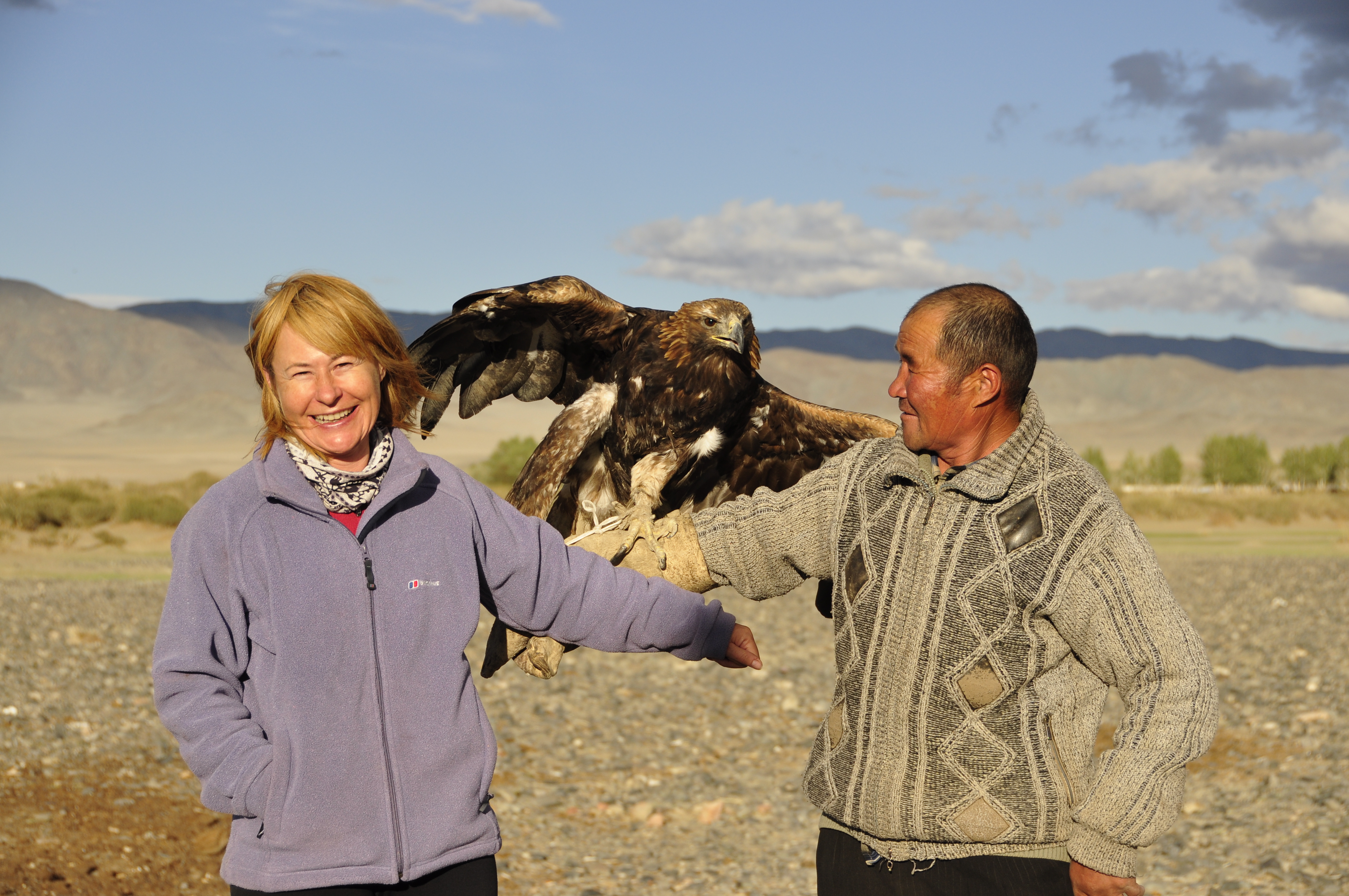
Dale pictured in Mongolia on a shoot to film the Eagle Hunters sequence from the Mountains programme.
Last Thursday saw the final episode of Human Planet transmit in the UK. I had mixed feelings as I watched the end credits roll for the last time. After three intense years, sending teams to over 70 locations including some of the remotest places on earth, this really did mark the end of the formal production process on the series. It is always sad when a production ends. Virtually all of my amazingly talent team have gone - many already on new adventures around the world. There is literally just a handful of us left in the Bristol and Cardiff offices.
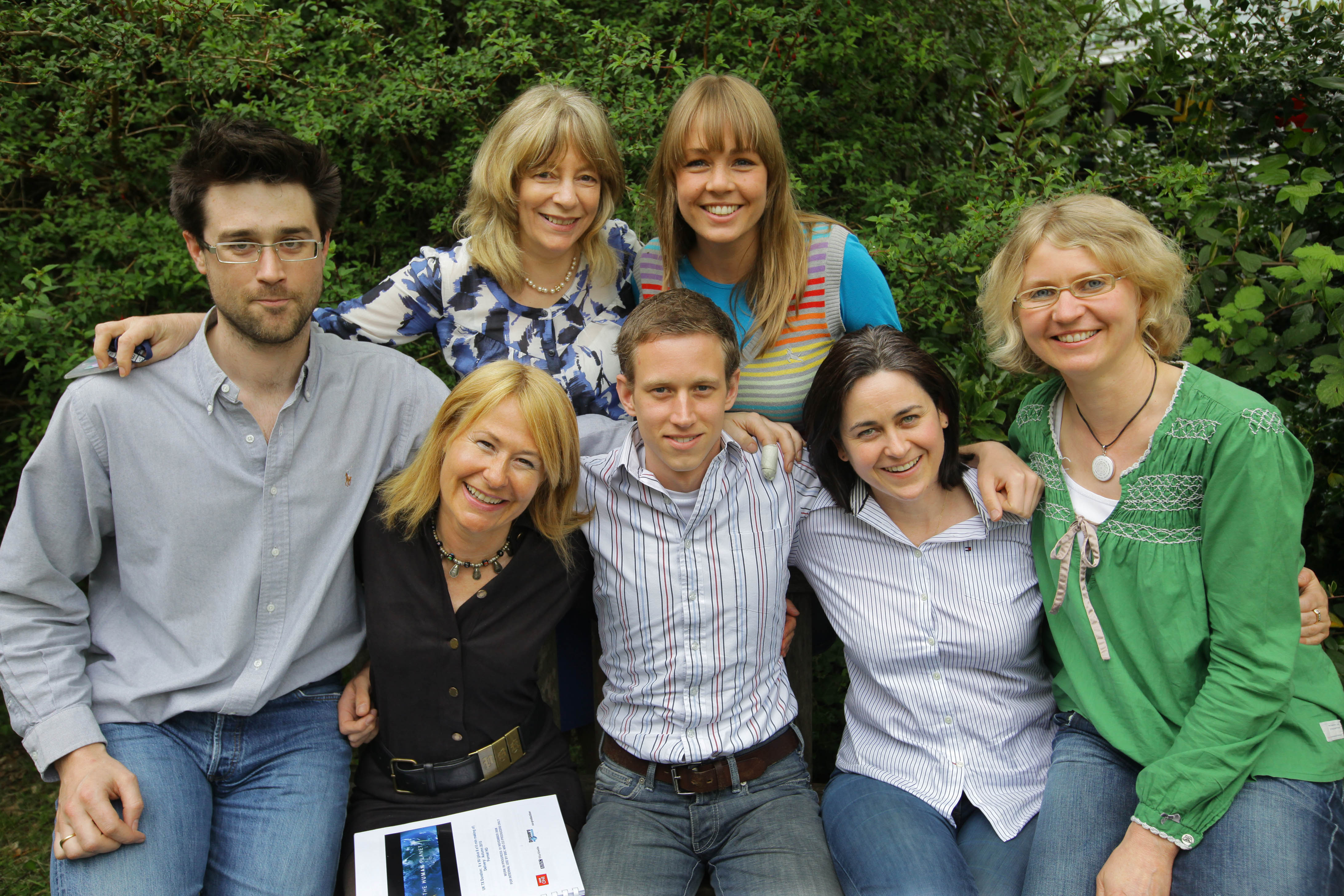
Dale with some of the Human Planet team. From left - right (front) Edit Assistant Craig Haywood, (Dale), Technical Co-ordinator Jasper Montana, Production Co-ordinator Isabelle Corr, Production Manager Alison Brown-Humes. (Back) Production Management Assistant Julia Wellard, Production Co-ordinator Jo Manley (Photo copyright Timothy Allen 2010)
But Human Planet has been different from any other programme I have ever worked on. Normally the last UK transmission would be the end of the series. For Human Planet it feels like a new beginning. For a start I am still in slight shock at the amazingly intense and positive reaction we have had to the series from people of all age groups. The series has been praised by members of the Royal Geographical Society, it’s been the focus of talk and gossip around office water coolers and it’s been making news particuarly online. I’m especially pleased that the series has connected with a younger audience - there’s been a buzz on Twitter and Facebook and millions of hits on You Tube. One young mum told me her 3 year old son was a huge fan of Human Planet, watching every episode without fail! No programme maker can ever be sure of a hit. This is a very fickle industry and audiences can never be guaranteed even when you’ve made a landmark series for the BBC. The feeling is that Human Planet is a fresh and different type of landmark. Many people, even those who don’t normally enjoy natural history have become hooked on humans!
Personally I hope this new found passion for humanity will continue. The series is a spectacular snapshot of the diverse human world we live in. But the world is changing fast, very fast. It’s becoming increasingly hermogenised. Even now one City looks much like the next - same Starbucks , same McDonald’s. Human Planet filmed with people who still directly depend on the natural world for their survival but their wisdom and customs may soon be disappear. The human species cannot be set in aspic but I think many of the stories we filmed will be gone within the next 10 years.
So what next? The series is now out on DVD/Blu-Ray and the book is in the shops. Next month it jumps across the Atlantic to be shown on Discovery Channel (a different version from the one showing in the UK) Then the UK version will start being shown on television around the world. So look out for Human Planet in your neck of the woods! Hopefully the BBC will commission a second series, watch this space…
So hopefully the end is truly just the beginning…I can only hope that this series sparks an interest in the challenges facing our human planet and that more is done to protect the incredible diversity, languages and cultures of our magnificent species.
Long live the Human Planet and all that sail on her!
Living with Lions
by Jane Atkins, Human Planet Researcher
‘You see, Lions and the Dorobo, we feed each other.’
‘If we hunt a large animal, we take away as much as we can, but leave the rest for the lions to feed on. And sometimes the lions kill a really fat animal and we say, lets take this one. It is not simple, you have to track carefully and quietly. You are scared.. thinking - will I be mauled?’
‘But when you are hungry and know lions have killed first - you take your chance. There are days when we eat only what the lion has killed. We live on those lion kills until we finally make our own kills.
When we filmed 3 Dorobo hunters stride up to 15 lions to steal from their fresh kill our hearts were in our mouths. Courageous? Ingenious? Suicidal? All of these perhaps, but this one act is undeniably impressive. The Dorobo say they are hunters just like lions. They watch lions, and how they hunt. Just as lions do, the Dorobo watch every animal on the great plains - and study each individual. Like lions they observe which ones are wounded, slower, easier to pick off. They wait and wait until the time is right to hunt. And if the lion gets there first, well the Dorobo turn that into another opportunity.

There are three lion prides living in the same area as the Dorobo. This 22 strong pride are just a few hundred metres from the Dorobo's regular camp.
But these opportunities are fading, and fast. These hunting and scavenging practices may be age old, but in 21st Century Kenya, they are banned under the country’s blanket law that no hunting is allowed in Kenya. Although the law was made primarily for big game hunters, it has been enforced at the local level, with traditional tribes, to avoid any ‘grey’ areas.
And so these Dorobo men are living a daily struggle of holding onto a lifestyle passed down through the generations; being free to walk through the great plains, hunt game to feed themselves and their family and sleep under the stars in caves and hidden valleys. Now, they all accept that although they were brought up to be hunters, they will not be bringing up their children to be hunters, to know the wildlife as intimately as they do.
Olkinyei is one of the last pockets in Kenya where the Dorobo still live, but in the last year, the area has been identified as a new conservancy, which means a step up in wildlife conservation in the area. This will ultimately push out of the Dorobo hunters.
And so in our lifetime, we will see an end to this ancient lifestyle of hunting, gathering and scavenging. An accumulative knowledge that has been passed down over 1000s of years.
In a time when stories about endangered wildlife regularly hit the headlines, few people seem to notice that incredible human cultures are being lost; ‘like swatting a mosquito - no-one seems to notice’. The irony here is that wildlife conservation has played a strong part in the Dorobo’s fate.
Whether you think this is right or wrong, it seems the fate for the Dorobo is inevitable. However, it may still be possible to keep their extraordinary tracking skills alive.
Today Jackson Looseyia, who runs a safari lodge in the Masaai Mara, has started employing Dorobo men to be spotters and trackers for his tourists. Jackson says, ‘If the Dorobo way of life disappears, so too does their knowledge. The Dorobo can spot and name any distant bird or animal, identify any nearby track or noise, and tell the story of hunt through reading the tracks in the sand.’
So perhaps this is one way for Rakita and his friends to keep their knowledge alive, even if their traditions die. It may not be as heart racing as hunting a buffalo, listening to the sounds of the night, or stealing food from a lion, but perhaps it’s enough? Rakita told me as we left ‘Of course I am sad to say goodbye to the life of my father, my grandfather… but what can I do? I cannot continue this life much more… I have already been in prison before now! And to bring up my son as a hunter here would be irresponsible. I don’t want him to go to prison. It is a shame, but what can I do?’.
If Human Planet achieves anything, a respectful salute to some of the people we filmed with would be a great thing. For the team back in the UK, finding some of these unique stories was hard, and filming them was challenging. But in a few years to come, these stories may turn out to be the last record of not just the Dorobo but many of the other people and cultures we were so privileged to film.
Watch the Dorobo steal from the lions here: http://www.youtube.com/watch?v=pNeNTMmltyc
Too Good to be True
By Karina Moreton
Mongolia has mountains, grasslands and desert, so it was a perfect location for filming some fascinating stories for Human Planet. When I was asked to be the teams’ fixer in Mongolia, I had a ‘pinch me’ moment – here was an opportunity for me to show off the country that I love so much , to producers at the BBC’s Natural History Unit! Armed with maps, photos and anecdotes, we discussed a wide range of potential stories and we settled on a few. Based in the UK , my role is to set up recces and shoots for film shoots. However, I am always trying to dream up ways to get on location myself rather than to be just co-ordinating from the office. The winter Gobi shoot for the Deserts programme promised to be a tricky one, so I wangled my way onto it.
In the weeks up to our arrival, my colleague Esee travelled to the remote South Gobi talking to camel herders about wolves. It was a big ask. We wanted to find a family who were affected by wolves killing their livestock; who had pregnant camels due to give birth during our time there; who lived near the snow line – who looked good on camera… and who were happy for a team of us live with them and film them for a few weeks!
Somehow the amazing Esee found the right candidates - camel herder Ganbold and his family. Once the teams started filming, I had a whole host of questions thrown at me ‘how do we film if the wolf attacks at night without freezing to death?”. One moment we would be discussing the likelihood of a snowstorm in the Gobi desert in the first few weeks of February; the next dealing with the fact that the only town in the South Gobi has run out of firewood.
I am sure the viewers will connect with these warm-hearted people and learn from their daily challenges. It is the moments that weren’t captured on camera that will remain with me – the time when 6 year old Otgonbayar and I shared the very intimate moment of a lamb being born; the serene solitude of his elder sister riding off into the empty desert with their flock; and the giggles shared with the girls in the ger.
Mongolia and her people have captured my heart. I am so happy that audiences around the world will be able to have an insight into the culture and landscapes of this incredible country. Over the years, I have gained so much from the Mongolian nomads I have spent time with. Panoramic Journeys, who I work for, always give back to the families and communities they work with. Ganbold and his family now supplement their income by hosting guests who would like to experience their lifestyle first hand.
Little Otgonbayar was keen to know when the photographs and footage that we’d shot would be seen by them all . I was four months pregnant at the time, and so it was handy to be able to say that the Human Planet book featuring the photos of stills photographer Tim Allen wouldn’t be published until my baby was running. I continue to pinch myself, for although my work for HP has come to an end, Ganbold and his family remain friends. My son is nearly walking now – but I will be returning to the Gobi with The Human Planet book and the series on my laptop very soon.
THE BBC COMES TO THE ‘OUTBACK’
by Phil O’Brien, Fixer
My name is Phil O’Brien and I live in a place called the Northern Territory of Australia. It’s a place you can wind your clock back a few years, have a beer, and live in peace. Spectacular, panoramic and wild, it’s a huge area, and there’s way more cattle live there than people.
I suppose I’ve lived a bit of a gypsy life drifting from job to job, and had my share of adventure and also a little misadventure in this great place. Everything from catching crocodiles to trying my hand at being a drink waiter… and everything in-between. But not so long ago, I got roped into one of the most exciting rewarding experiences of my life, and I’ll never forget the day the BBC film crew came to the ‘Outback’.
The phone rang with a sharp electrified burst, directly over my left ear, was way too early for a bloke that had been drinking beer after beer, some short hours before. Somehow I got the phone to my ear and answered.
The BB who? BB what…eh, excuse me?
Well, the sweet melodic voice of charming BBC Researcher Jane Atkins never missed a beat. ‘We need a ‘Fixer’ she politely announced. Now me being still half cut and not understanding film terminology, did what any respectable citizen of the Northern Territory would have done…hung up and went back to sleep.
During the next few days Jane Atkins followed up with more calls and information, dedicated and relentless in her pursuit of organising the film shoot, which had to be in the heart of Northern Territory cattle country. I tried to explain that Territory cattle country can be hard, merciless and unforgiving …and that was on a good day! But Jane Atkins stuck to her guns, and wanted me to help organise something that was going to be bigger than Ben Hur. What an honour! This wasn’t going to be no ordinary Mickey Mouse documentary, the BBC wanted to get right down in the bulldust and cow dung and film a rip roaring helicopter cattle muster in one of the world’s last frontiers.
It was a big ask, but Jane Atkins had come to the right man.
I knew just about every bloke, every horse, and every anthill in the Northern Territory. I knew that when it comes to cattle, one man had risen to the top and in a tough environment that breeds tough men, that’s no mean feat.
Big bustling ‘Ben Tapp’ was no ordinary legend.
Built like a brick toilet block, Ben Tapp liked to sprinkle horse shoe nails on his muesli…. he knew no fear. Ben Tapp was one hundred percent pure Territory cattleman, and when I told Jane he also flies a helicopter like a man possessed, the stage was set. Ben Tapp took no convincing, he always knew he was a larger than life character and it was only a matter of time before he hit the big screen.
The day finally came and the BBC film crew landed at our humble airport in the Territory capital of Darwin. What a fantastic bunch of people, I thought to myself as the introductions flowed and the pommy accents filled the air. They were a star studded line up, the best in their field. Jane Atkins was even better looking in real life than I imagined and the cameraman was a friendly bloke called Toby Strong. Accompanying them was the director, charming Susan McMillan, and technical assistant and roustabout, Jasper Montana. Sound man Ian Grant who flew in from Queensland. After a flurry of baggage, camera and sound kit, hire cars and groceries, we headed off on our 600 kilometre journey down to Maryfield Cattle Station, home of the legendary Ben Tapp.
Right from the start I really liked their humility; there was no big egos, no pretence, just a great film crew chomping at the bit. Keen to roll it, wrap it, and get it in the can.
We broke our journey after about 300 kilometres at Katherine, just in time to witness a fairly lively punch up between a couple of locals at the petrol station. The BBC film crew weren’t too fussed, they’d been all over the world, and two bantam weights swinging like rusty gates weren’t about to freak them out. Next stop down the track a bit was the one horse town of Mataranka, population 200 [including cattle].
The BBC was starting to get hungry so I steered them over to the Pub. Inside there were people propped up drinking furiously. It was like ‘God’ had personally just rung the pub and told them the world’s ending in half an hour, so get into it. In amongst it all was the publican, a glamorous lady called Deb, wandering around in a beautiful flowing gown, quite a sight in amongst all the rough necks. I introduced her to the BBC film crew. If she’d had a red carpet she would have rolled it out but instead she cooked a great feed of Barramundi and chips for everyone, she was a great host.
With Barra and chips hanging off our ribs we made the last few hours to Maryfield Station and finally everyone had a chance to meet Ben Tapp. It was all very warm, and although Ben is tough, hard, wild and all the rest of it, he is also a very generous bloke, and he totally opened up his house and his property to the BBC film crew, and nothing was going to be too much trouble. Ben’s hospitality really was first class. He was right on the ball, he had 2000 head of cattle to muster and he had his young team of stockmen fully briefed. His right hand man on Maryfield was a bloke called Rankin Garland who also was a gifted chopper pilot. Right from the start everyone really hit it off.
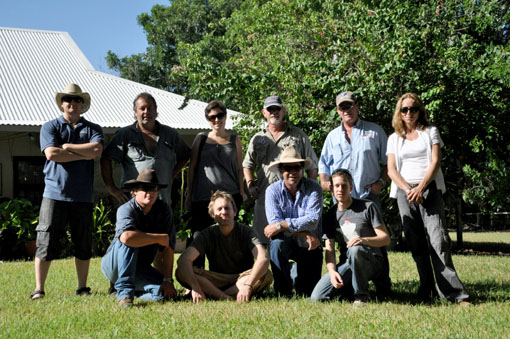
Back Row(from left) Warick Field[Cineflex Camera Operater
The next ten days for me were just unreal, I got to see a world class film crew in action and I was totally inspired. Camera man Toby Strong went from sun up to sundown and still had energy, I remember one time he was hiding in a bush filming cattle as they filed passed, a snake came out of nowhere and slithered over his leg, but he never flinched, he just kept filming. There was no stopping him, where ever the action was, there was Toby.
Susan McMillan was a great director and she brought the best out in everyone, she and Toby made a great creative team. I felt sorry for her a bit because I was doing the cooking for everyone and so all my meals revolved around meat, meat, and more meat, poor old Susan was vegetarian and I can’t actually remember her eating anything the whole ten days. She would have paid big money for a lettuce.
Susan, Toby and Ben communicated really well and as the whole focus was on helicopters and mustering, Ben and Rankin didn’t disappoint. Their aerial work was breathtaking, and Ben really got into the whole film thing. He was actually coming up with great ideas for shots and where to put the camera and what angle and stuff. He was proving very artistic, in an outback type of way. Obviously under that tough, rugged, exterior was a sensitive creative new age guy.
Jane Atkins reminded me of the ‘Holy Spirit’, she was everywhere at once. Unstoppable and three months pregnant, she was the rock of Gibraltar. Jane has such a calm beautiful nature, whether it be out in the hot sun assembling the camera crane, or curled up in front of the computer like a cat, watching over everyone. Technical Assistant Jasper Montana was running around like an unregistered dog, tirelessly helping where he was needed and never complained. Sound man Ian Grant was the total professional as well and spent many hours following cattle around, taping their every bellow.
The only drama was when a Jet Ranger helicopter fitted with a special Cineflex camera that the BBC had hired looked as though it wasn’t going to make it. This caused a bit of concern as the special Cineflex camera was crucial to the whole thing. But Jane, after numerous phone calls and emails, and with a little help from God, made it happen.
After days of filming Ben and Rankin doing their wild manoeuvres in the choppers, and cattle wheeling to and fro through the scrub, it was time for the grand finale. It was time for the big money shot. Two thousand head of disgruntled beef had to be brought in and yarded up. It really was a great spectacle and all the many hours of planning really came off. With the Jet ranger and the Cineflex camera high up in the sky taking in the whole vista, Ben and Rankin set about driving the mob into the yards in their dragonfly-like mustering choppers. Through a veil of dust the choppers weaved, pitching, diving, steering the frenzied mob in towards the yards. On the ground were horsemen and motor bikes turning back any beast that tried to head back to the scrub. Toby Strong of course was courageously right in amongst it all getting some of the best shots I’ve ever seen. Ian Grant, camouflaged in the trees, captured some great sound and everything went off brilliantly. The BBC had won the day!
With the cattle yarded, big bustling Ben Tapp landed and rolled himself a well deserved smoke, it had been tough, but all in a day’s work when you’re a legend.
Next day was the completion of the filming. After a humongous party that night, it was time to pack up all the kit and head back to Darwin to get the film crew on the plane. There was many a teary eye and a hazy hangover as we all said our goodbyes. Friendships were made and it really had been a special time. Whether we ever see each other again who knows?
But one thing I know for sure, the Northern Territory will never forget the day the BBC came to the ‘Outback’.
Little Human Planet
by Elen Rhys, Producer, Little Human Planet
When delightful Dale Templar told me that Human Planet had been commissioned, my brain immediately started working overtime. Waw, what a great opportunity for a children’s spin off on CBeebies. Surely, if they would be filming humans in far flung and remote locations around the world, they were bound to be meeting children too. What a unique chance to work alongside this huge landmark commission to create something special for the BBC’s youngest viewers. And basically, that is how the CBeebies commission, Little Human Planet came to be.
Little Human Planet is a little sister series to Human Planet. It consists of 16 x 5 mins programmes that will be broadcast during the same period as the main series – but of course, at a time when 3-6 year olds are at their most attentive.
It’s a simple idea with a simple format. Each programme follows a typical activity in the life of a child from around the world – a glimpse to a CBeebies viewer of how their counterparts live, wherever they may be. On reflection, an unspoken celebration of what makes children different and what makes them the same in a colourful and often surprising voyage of discovery.
Unfortunately, I didn’t get to pack my passport to film the sequences. This was done by the brilliant Human Planet location teams. Yes, we liaised closely together regarding style and vision, understanding that certain things like nudity or blood and gore couldn’t be used. Naturally, this proved difficult in certain locations where few clothes, if any are worn and hunting for food is the norm. I was never sure what I was going to get, only crossing my fingers they would meet some children and film some magic moments . I’m used to having a bit more control, so this was quite difficult for me but I soon realised I needn’t have worried.
Each time a team came back with special Little Human Planet labelled footage it was like the anticipation and excitement of opening Christmas present. Who would, Dan Young, my editor and I meet this time? Could it be Dua, a six-year-old girl who lives in a tree house in a jungle in Papua or mischievous four-year-old, Carlos Eduardo, who lives on the flooded banks of the Rio Negro? Or how about four-year-old Shoree helping her dad build a ger home in Mongolia, or three-year-old Edjongon, who walks long distances each day to collect water from a well in Mali? Even though I have never met these fascinating characters, I feel as if I know them. And though the children’s experiences, circumstances and environments differ hugely, I learnt that at heart children are all the same and their smiles are universal.
Yet, paradoxes come to light. Without generalising, many of these children and families have very little, but yet, seem contented where community and sharing is a way of life. It taught me a lot and got me thinking..As a mum to a six-year-old, have we in the Western world lost our perspective ?
I am honoured, grateful and proud to be a tiny part of the Human Planet family and I hope there will be more opportunities like this in the future. If so, can I please come next time?
Dale Templar - Series Producer
Here’s hoping - Elen!
Little Human Planet is one of spin-offs programmes and extras that are part of the Human Planet . We have already had a post from our team at BBC, Radio Three working on Music Planet and in a few weeks we’ll have one from our BBC Learning team. They are using our footage to make programmes that will be used as teaching aids in scools.
Navigating the Urban Jungle
Human Planet crews have become used to their senses being pushed to the extremes in tough environments across the globe- blistering heat, pungent odours, jaw-dropping sights, ear-splitting sounds and palate-stretching cuisines. But at the end of eight days of filming in New York City, the crew had to admit nothing had prepared them for the frenetic energy of Manhattan - the very definition of an all-round sensory assault.
Tens of thousands of TV shows and movies are filmed here every year, but even though Americans technically speak the same language, when you’re not a native, a guide is advisable. That’s where I come in. As a former BBC Wales Assistant Producer who now lives in NYC, I join the team as a ‘fixer’ which has a nice Mafioso ring to it. In practice, it means everything from Locations and Casting Manager to Assistant Producer and Local Restaurant Expert.
In the midst of the August humidity, when anyone with sense and money leaves the city, the crew arrive for filming. Director Susan, Cameraman Toby and Soundman Nick have just flown in from Bristol when I meet them at their hotel in the Flatiron district. We have seven days to film two stories for the last episode of Human Planet the Urban programme. We will be covering rooftop beekeeping, a growing trend here since legalisation in March and the slightly less romantic topic of man’s ongoing battle with rodents in the city.
The next morning we’re joining the frantic pace of New Yorkers with a 6 a.m. start at location, to set up a 30 foot long filming crane in a packed Farmer’s market in Union Square. That was to be the easy start. Over the week we fight the weather, the crowds and the traffic. We climb eight storeys with heavy equipment to a farm amongst the skyscrapers, try not to get stung filming honeybees on a factory rooftop, tread through rat-infested restaurant basements and hang around lots of dark alleyways. We also spend a lot of time in the production van, crawling through the congestion, watching our carefully planned schedule tick by.
Then there is attempted extortion by some locals in Chinatown and getting chased by some angry graffiti artists in Queens. One day there is 5 a.m start, another we don’t finish until 4 a.m. And then because every hard-working TV production unit needs to wind down, there is night out which ends up with some crew members riding a mechanical bull in a Lower East side bar. As a finale there is an unconfirmed case of Martini poisoning.
At the end of it we are all burnt out. New York City has performed its most common trick of chewing everyone up and spitting them out on the rubbish strewn sidewalk. On the last day we film some shots in Central Park, the great, green goddess of Manhattan. As a Welsh girl used to lots of trees, it’s a place which has often saved my sanity, simply by allowing me to feel the grass beneath my feet.
When the crew step onto the sprawling Great Lawn, they seem to come back to life. Around them are postcard-pretty flowers, birds humming and lots of open space. They all confess to me they’ve just realised what they’ve been missing over the last week. More used to The Amazon than the Concrete Jungle, they’d felt quickly hemmed in by the city. Now they were themselves proving the very essence of what Human Planet is all about-that no matter where humans choose to reside, they will eventually seek out the natural world.
We all stop and breathe and stand very still, in the calm amongst the insanity of New York City.
Music Planet: Andy Kershaw Keeps His Head
by Roger Short, Producer, Music Planet , BBC Radio 3
In March this year, on his first trip for Music Planet, presenter Andy Kershaw visited the Solomon Islands. This was the most remote area either of us had ever been to, so we decided we really should find some people – and music – that were as far away from western culture, particularly the influence of the Christian missionaries, as possible. So we took a small plane to a grass runway on Malaita Island, drove in a truck for two hours, took a boat along the coast for an hour, and finally reached a village of the Kwaio people. Even here a church and a school awaited us. But after a three-hour steep trek up a mountain, we arrived at the remote Kwaio villages which still follow animist culture. They weren’t exactly geared up for visitors, so our team of five (including engineer James Birtwistle, plus local guide and interpreter) all slept together in a tiny hut on stilts. Dinner was a cauldron of boiled potatoes. Fortunately the music more than made up for it.
First we heard the music of the ‘gilo stones’ – two players with bamboo sticks in hands and feet, knocking them on smooth stones in complex rhythmic patterns that Steve Reich would be proud of. Then the head of the village sat in a circle with four other men, gently beating out a rhythm with sticks, and first humming, then chanting an epic song. They later told us it was about the murder of a former British Governor who had tried in vain to impose taxes on the Kwaio. Andy asked them if they were former head-hunters. They queried the word ‘former’ – ‘we do reserve the right’, the chief said, ‘if it became necessary…’ No further challenging questions were asked.
Dale Templar, Human Planet, Series Producer says:
I can’t wait to listen to “Music Planet”. It is the BBC Radio 3 sister series that will accompany “Human Planet” when it transmits in the UK early in 2011. The Music Planet” team have been travelling around the world recording music from people all the different environments we have been to on the main series but in some cases they have visited different tribes and groups of people.
The Secret of Pigeon Poo
Morocco is a land steeped in a history as rich and as colourful as one of its most prized commodities - leather. We made our way to the ancient city of Fes (or Fez) where men have been tanning leather for over six centuries. This elaborate process has barely changed in those six hundred years and we were lucky enough to be guided through the many processes by Tammy, a young man already immersed in the art.
The Tannery itself is a collection of vats, dedicated to the different processes of tanning animal hides. There is a vast area of vats filled with liquid lime, in which the hides are immersed to soften them. This is an extremely dangerous process and the tanners go about their task with the barest of protection from the skin-burning lime. The crew survived unscathed except for the odd splash but this was enough to make us extremely wary.
From here the hides are washed in what can only be described as giant skin washing machines, whose constant drone supplies the tannery’s sound track. The next stage is the part we were especially interested in filming - the process of using pigeon poo to make the hides extremely supple. The droppings from wild pigeons are the only ones our character Tammy uses as they’re guaranteed to have a high level of ammonia, unlike their caged cousins. You see working for the BBC teaches you things you never knew you needed to know!
I have somehow managed to skip trying to describe the smell the Tannery emits… but here goes.. It’s like a thick mist, which is invisible to the eye but apparent to the skin, hair and especially nose of the unwary visitor. Our first day in and our Making Of cameraman, James Aldred, had a few close calls trying to keep his croissants down. All of us were totally taken aback by just how intense the smell was; it can only be described as smelling of rotting flesh with a tinge of sweetness. Oh yeah and add 40 degree heat to that recipe as well.
We shot some of the sequence in the Medina; this was a magical experience for me as it felt as if I was going back in time. The Medina in Fes is famous for its many winding narrow streets, the air filled with the smell of exotic spices and the sound of street sellers offering their wares to the haggling masses. Morocco has left a lasting impression on me and given me the urge to explore more foreign and ancient lands; a road trip across North Africa might be on the cards…Any takers?
Basket Trouble in Mali
by Cecilia Hue, Assistant Producer, Deserts/Grasslands Team
This is my last filming trip for ‘Human Planet’ and I am going back to Mali, which has become my second home since I joined the Bristol team a couple of years ago. The journey starts with the most extraordinary beginning, the stuff of Hollywood movies. A volcano which no-one has ever heard of, with an unpronounceable name, erupts in Iceland and spews so much volcanic ash into the air that European air space has ground to a halt - the morning we were supposed to fly to Mali! What would normally take five and half hours by plane ends up taking over 100 hours! Our production co-ordinator Isabelle Corr cool as a cucumber, as ever, (see photo below!) cunningly devises a roundabout route via ferry to northern Spain, a drive to Madrid and two flights that finally land us in Bamako, Mali.
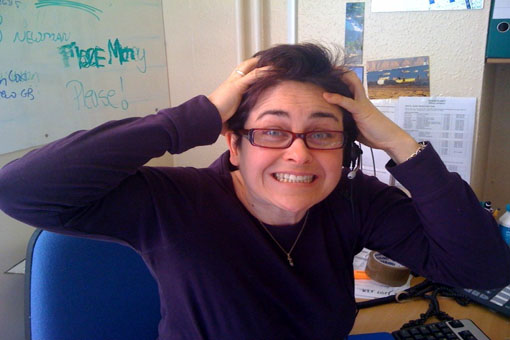
Isabelle in the office
We are determined to make it in time for an event which only takes place once a year: a fishing festival in the desert, possibly the most dramatic sequence in the Deserts programme. Once in Mali we still have a two-day journey by road before we get to location. It is incredibly hot, 45 degrees (which for those who have never experienced it feels like having your head stuck in an oven ), we get punctures, and an incredible sandstorm which leaves the whole team caked in a layer of orange dust. We look as if we’ve all been ‘Tangoed’!
We finally arrive in the Dogon village of Bamba, built among boulders at the foot of an incredible 500 m high escarpment which cuts through the monotony of the Sahel for over a hundred miles. Everything here is parched as the dry season reaches its peak, leaving only one sacred pond full of catfish (which have retreated to this last haven as all the rivers dried up).
It’s 7am on Saturday 24th April. The day of the fishing festival has finally arrived. The Dogon are very superstitious. Women are not allowed anywhere near the sacred pond. As I am the only woman in the team I am gently ushered away from the scene by my fixer. I am told that I might lose my fertility if I stay. Frankly, I am not prepared to take any risks so I join the other women in the village. They are all busily getting ready for the celebration – braiding their hair and pounding millet for the big feast.
In the meantime, the crew is preparing to film the fishing frenzy which will last no more than 15 minutes and is unrepeatable for religious reasons. There’s no room for error. 4000 bare-chested men -including our character Amadou - have turned up to the pond the size of an Olympic swimming pool, armed with their cone-shaped fishing baskets, ready to charge in. They hope to catch a fish or two. If they do, they believe it will bring good rains and a subsequent abundant harvest for their family and their village.
Our character is fortunate to have made it to the festival. The day before, he almost got kidnapped from the film set by a mob of angry men from the neighbouring village. We had caused deep offence by bringing his fishing basket onto their territory. We soon discovered that the basket was a painful reminder of the village’s defeat against Bamba in the battle for control over the pond. We had made a terrible basket faux pas! We apologized profusely to Amadou’s arch enemies and were asked to give a small payment to repair the harm.
To see the full story of the fishing festival, look out for the “Human Planet” Deserts programme!
The Musical Language of Human Planet
by Nitin Sawhney, Composer for Human Planet
Well… Life working on “The Human Planet” has been quite revelatory.
Since working on Human Planet I have been repeatedly astounded by images of
human resilience from around the globe… stunning visuals of men taking casual strolls on seabeds (without breathing apparatus!),
stick fighters, Arctic hunters and rainforest bridge builders have
filled my computer screen daily with inspiration.
As it is my job to score this wonderful 8-part series, I find myself
constantly suspended between disbelief at the possibilities of
environmental adaptation and exhilaration at the prospect of scoring
arguably the most profound documentary narrative ever broadcast.
Creating the musical vocabulary for such disparate programmes is no
easy feat, however. Besides attempting to musically express the arc
and nuances of each individual episode, it has been my task to also
find a cohesive musical language for the entire series as a whole.
Over the next few months I will be scoring and orchestrating epic
scenes for the National Orchestra of Wales, various specialist
musicians and singers and most importantly attempting to find the soul
of this beautiful tale of human determination.
Dale Templar, series producer, is acting as my guide and mentor over
this period, helping me to navigate my way around the individual needs of directors, the meticulous executive review process and that search
for motifs, ideas and a musical vocabulary worthy of such classic
scenes.
I will be updating you as I go, not only on all of this but also the
ongoing discussions over Human Planet – Live!
Cheers
Nitin
Papua New Guinea - Wild Frontier
By Nicolas Brown, Producer/Director, Arctic and Mountains Team
Papua New Guinea has the feel of the Wild West. Because it’s a mountainous tropical island it doesn’t physically resemble a Spaghetti Western, but the larger than life characters and the ever-present threat of violence make it a frontier. This could be a set for Clint Eastwood- with a pierced nose.
As our small airplane nears its destination—Wewak town- we fly over the mighty Sepik River. Braided into a wide Delta of graceful interlocking ox bows, this is how rivers used to look hundreds of years ago. No channels or dams or bridges. The wildness is just a taste of what is around the corner.
On our descent, we are treated to a breathtaking overview. Wewak town is in the shadow of Mt. Turu, a 1600-metre high peak covered in dense jungle. But the real story—the one we have come to film—lies beneath the canopy, where literally hundreds of tribes make their living on the steep mountain slopes. My burning question is—exactly who have we come all this way to film?
In Papua New Guinea there are over 700 distinct tribes, in the East Sepik province (which is half the size of Ireland) there are 88 distinct languages spoken. Around this one single mountain- Mt. Turu- we counted 7 different ethnic groups. In terms of people, this place is wildly diverse.
This is the home of cannibalism and many say there are still tribes in the mountains that cannibalise each other. As recently the 1970s, four Dutch families were killed and eaten. Two years after that a priest and his 12 companions were killed.
Possibly more worrying for a BBC film crew, Wewak is famous for cargo cults. Prior to this trip, I had never heard of such a thing, but evidently during WWII the Japanese and Americans flew a lot of supplies—cargo- to the region. Once the war ended, the cargo stopped coming. In an attempt to get it back, local tribes evolved religious rituals that mimicked the activities of soldiers, such as wearing “headphones” made of wood and speaking into “radios” woven out of straw. You’d think they would have got tired of waiting for cargo by now, but evidently not.
When I suggested our original plan to fly to our location using helicopters, the image of us arriving from the sky with dozens of boxes of film equipment filled our local fixer with dread. “Are you crazy? You cannot come out of the sky carrying boxes of what looks like cargo—that would cause big trouble.” But, as we are about to find out, “big trouble” is coming anyway, in a different guise.
It starts on our first day. We had just loaded the vehicles with our filming equipment when the hotel owner enters and announces that a week ago, there was a jail-break in Port Moresby’ maximum security prison. Twelve of the most notorious criminals in PNG had escaped, including the most notorious of all—William Kapris. The hotel owner goes on to say that someone has just hijacked a 4×4 vehicle earlier this morning. Since William Kapris grew up near Wewak, the inference is that Kapris is back and is collecting 4x4s to escape into the mountains.
Two of the best 4×4 vehicles in town are ours- parked in front of the hotel, full of our gear. We debate our options. Some are suggesting that a BBC film crew would make a useful bargaining tool for a desperate criminal gang. Do we keep filming? Or do we hide in the hotel and watch the armed guards patrol the perimeter, while we put our feet up and drink beer? The decision falls to me.
I look at the sky which is moody and dark—this is the rainy season, and if we don’t leave now there’s a real chance that the roads will get so muddy that we will never reach our location. So I say, “let’s go filming, but keep our eyes and ears open.”
Of course, the minute we leave the hotel, everyone is a suspect. That man by the hedge—does he look like a mass murderer? That boy playing with his football against the wall—is he going to phone Kapris and tell him the 4x4s are on the way? On the road, the woman with her bag of vegetables—I imagine she is William’s sister who eventually liaises with the international hostage negotiators, saying “Don’t you think a BBC Producer’s life is worth a little more money than that? Pay up.”
Our visit to the local police is not encouraging. The Commander in Chief sees the BBC coming, and seizes a press opportunity. “Everything is under control—we have shoot to kill orders, and we are sure that we will find him and he will die.” I wanted to tell him, “We don’t care if you catch Kapris or not—we just don’t want us to be shot in some kind of crossfire confusion,” but I bit my lip.
We drive to our location without incident. At the village we are welcomed by the elders, and by our fascinating hero, Marcus. Marcus is a Yangoru Boiken hunter, but to the locals, he is a man feared for his magic powers.
To get our gear out to Marcus’ hunting grounds requires 40 some porters. So the whole village it seems comes under our employ. Our fixer AJ, who has done this before, makes a clear list of everyone’s names, and what we will pay them. And we set off.
On the way we are told never to stray from the path—not even to pee. Evidently, people from rival tribes will hide in the bushes, and then will leap out and stab you with a syringe filled with the poison of the giant centipedes that live here. Apparently it’s a very painful death.
Why someone would want to randomly murder you is not made clear. When I ask, the only answer that comes back is “witchcraft”. In the end I conclude that it is an effective way of controlling us—like telling children ghost stories so they don’t go wandering off at night.
We eventually film our sequence—which is a wonderful gothic tale that has never been filmed before. Marcus and his fellow hunters try to catch the giant fruit bats that fly over the canopy in the dead of night. How they catch them is ingenious and you can find out the whole story when you watch the mountains episode of Human Planet. 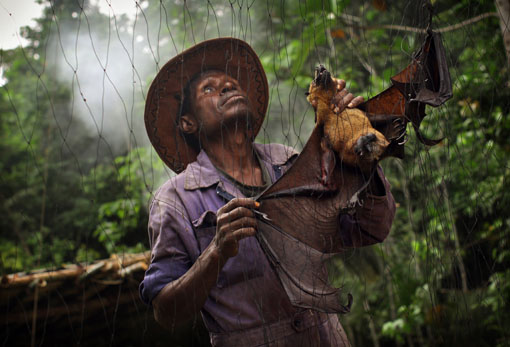
- Marcus capturing a bat in the net
We get to a point in the filming where we need to move locations to a different gap. It means a change in location, and a change in porters. So we are paying the porters and the trouble starts. Most people understand that in order to get paid, they need to have put their names on a list when they carried a load for us. But a few shifty looking men (who none of us had ever seen before) declare that they had worked for us but their names weren’t on the list. It gets heated. People are slamming fists, arguing with each other and with us. I can see the violence escalating.
So we decide to pay everyone double. And leave quickly. This puts a huge hole in our finances, but at least no-one has been hurt.
At our new location, there are more fees to be negotiated with the landowner. And we’re low on cash. But we make a deal, and begin filming. Then after about half a day, a man comes crashing through the jungle with a few henchmen wielding machetes. He declares that we are on his land, and he needs payment, or he will take action.
We explain that we have a deal in place with one person who owns the land. So who is this new guy? He says, “I am Joseph, tribal chief and the elder brother of the landowner.” Which makes Joseph a more senior landowner. And Joseph wasn’t informed about our project, which is against the tribal law. We immediately halt filming. We are back at the negotiating table.
Joseph has a remarkable command of legal sounding phrases, like “grievance” and “landowner rights”. And he wants money—a lot of it. And if we go home now, we can’t finish the film. Joseph seems to know this—he has a highly intuitive grasp of the art of blackmail.
Throughout the negotiations, I wryly note that Joseph’s younger brother—who we made a deal with in the first place—keeps schtum. He sees the possibility of more money coming his way, however indirectly. We are stuck, without enough cash to pay up, and with a half shot film.
Then, a few of our porters come over with a suggestion. They don’t like the blackmail that is going on, and they’ve never liked Joseph. He does this sort of thing all the time, and keeps all the money to himself. So they helpfully offer to get Joseph “drunk.”
“Oh that’s a nice gesture,” I say, “but it won’t really solve this predicament, will it?” They go on to explain that “getting someone drunk” is a euphemism for taking them into the woods and chopping them into bits with machetes. I can’t contain my horror—“Lord, no, don’t get him drunk! I don’t like the old codger, but that’s going way too far!”
In the end we compromise on a reduced fee for Joseph that pretty much ensures our “end of filming celebration” will be us drinking a round of tap water in the airport lounge. And Joseph is so pleased that he managed to squeeze more money from us that he invites a bunch of his friends to come watch us film. Every time he catches my eye, I wince, and it amuses him immensely. But we get the job done.
On our return journey I catch wind of a radio programme. It’s an English language call in show, and a voice speaks to the host. “This is William Kapris.” I am stunned by the meekness in his voice. To this day, I have no idea if this is a true story or just a prank, but the man claiming to be Kapris explains that the whole jail- break was organised by the government so that they could execute him on sight. It seems he knew some things about high-ranking officials that they didn’t want to come out in his trial. Now he’s on the run—maybe in Wewak—wanted dead or alive.
Like I said, Papua New Guinea is a bit of a frontier, and Wewak town belongs in the Wild West. Kapris is Jesse James. Joseph is Billy the Kid. And we are just a bunch of Westerners whose pockets were easily emptied.
Masters of the jungle
by Willow Murton, Assistant Producer, Oceans and Jungles team
There are places that you imagine you may return to and people you may meet again and then there are farewells to people and places you assume you will hold as a treasured memories. For me Aurelio village was one of those places; so remote, so distant, one of only two communities where the Matis of Brazil live. Set in the vast indigenous Vale do Javari reserve, it takes several days’ boat ride to reach the village, as well as many months of painstaking preparation. I had first come here to make the series “Tribe” and couldn’t believe my luck when I was asked to make a return trip for “Human Planet”– a rare privilege.
There is good reason to return to this remote corner of the Amazon for Human Planet’s Jungles episode. The Matis are true masters of the rainforest. Pete, our endurance fit cameraman, and I are reminded of this on our first filming day. An hour into the hunt we’d come to film, we are up to our knees, even thighs at times in swamp mud, soaked through by the unrelenting rain and all eyes on deadly poisoned darts being fired over our heads! Pete turns to me and asks if it’s all going to be like this?
Luckily it isn’t. Thank goodness, our second hunt is on firmer, drier ground. We follow the hunters into their world, immersed in the sounds and signs of the forest as we track monkeys in the canopy. For all the planning, there are still situations that happen which are unimaginable and that can never be relived. After many hours hunting with no success, we are about to give up when suddenly a troop of monkeys scatters across the trees. The hunters follow, taking aim in the tree tops. The camera’s eye is no match for the trained focus of the hunters. They find their mark fast and before long, they are tying dead monkeys together to carry them back through the jungle. Exhilarated by the speed and skill of our forest guides, we head back to camp just as the rain starts to fall.
Part of our return journey is by boat. There we sit, the two of us, blowpipes and cameras balanced on benches, monkeys at our feet and a group of hunters devouring the last of the snacks that we brought. Survival in the jungle is about taking the opportunities that it offers – and a camera crew’s rations are as fair game as anything else found in the canopy. Pete turns to me, waving the sandflies from his eyes, and he utters the words no traveller should speak: “Imagine if we got stuck here now”.
At that moment the boats motor clunks and we are indeed stuck – the hungry hunters and us up an Amazonian creek with no paddle! The boatmen, calm as ever, are quick in their evaluation of the situation. The motor is beyond repair but we are not beyond help. Bushe, the Matis translator who I also worked with four years ago, turns to me and instructs me to use the satellite phone to contact the village to arrange a rescue. It will be long soggy bug filled few hours before anyone can reach us. We ask Bushe what they would do without the BBC’s technological intervention. ”The forest has everything that the Matis need”, he replies and every Matis knows the paths that winds through the forest to the village.
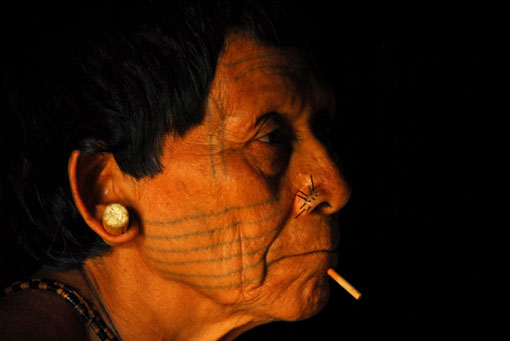
This is Tupa. She guards and administers frog poison rubbed into the hunters' arms to purify them before the hunt
We cover ourselves in insect repellent and lie back on the roof of the boat in beautiful resignation to the sunset and our eventual rescue. What passes in the next few hours is one of those gifts of disguised fortune – stolen time and experiences. Floating across the river, the boatmen set nets and within minutes, they have gathered a dozen fish for supper including piranha. Soon, we are back on the bank, in front of a bright fire, stabbed with sticks of fresh fish. We joke around the flames, laughing into the smoke. The fish is quickly eaten with the bizarre addition of fruit flavoured rehydration salts for those who prefer their piranha on the tropical tasting side.
Then we all wash in the river, as our socks dry on sticks over the embers. Laughing still, we clamber back onto our boat. The sunset darkens to a thick sky studded with stars and the sounds of the forest once more. Somewhere in the distance, a motor can be heard but for the moment, the jungle absorbs us entirely. It is so good to be back amongst my Matis friends.
Contact is Complicated
By Rachael Kinley, Researcher, Oceans and Jungles team
There have been a few times when people, and their stories, have really choked me up on location. Often it’s in interviews, when I get the chance to ask people about their lives, motivations and past experiences. The anthropologist in me loves this pause amongst the frenetic requirements of filming, being able to linger in the moment, and ask personal questions that wouldn’t come up in day to day small talk.
My most recent interview was with Pikawaja, a member of an Awá-Guajá community living in Maranhão, Brazil. Many of the people in this community were first contacted by the outside world in 1980, but some members of the village were only reached as little as three years ago. Since contact, it’s been quite a rapid, and sometimes rocky, process of assimilation. FUNAI and the government have given them motorboats, television, a satellite dish, running water, refrigerators, cattle, horses, a health clinic and schooling.
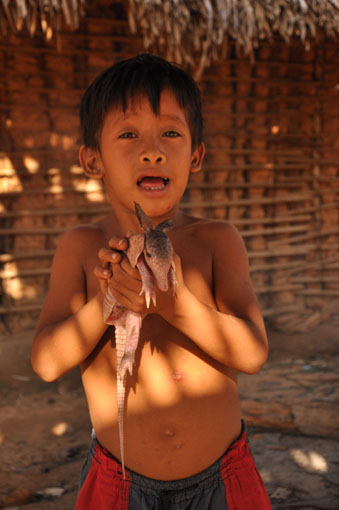 Although at first daunted and perplexed by the stark and dramatic alterations to their lives, most Awá-Guajá now seem excited by the change. Signs of the influence of wider Brazilian society are visible all over the village; children play by acting out scenes from Rambo, teenage boys sport bleached-orange mohawks and girls have started to pluck their eyebrows. However, the Awá-Guajá are in an odd situation where they are offered tastes of the world outside their reserve, but are discouraged from leaving to embrace these wholeheartedly.
Although at first daunted and perplexed by the stark and dramatic alterations to their lives, most Awá-Guajá now seem excited by the change. Signs of the influence of wider Brazilian society are visible all over the village; children play by acting out scenes from Rambo, teenage boys sport bleached-orange mohawks and girls have started to pluck their eyebrows. However, the Awá-Guajá are in an odd situation where they are offered tastes of the world outside their reserve, but are discouraged from leaving to embrace these wholeheartedly.
The childhood play and image-consciousness may be what’s seen on the surface, but I learn more about the increasingly complicated and more personal aspects of how the contact process has directly affected Pikawaja’s life.
Our interview begins slowly, following several relocations due to intrusive sounds from cockerels crowing and a pet howler monkey in desperate need to relieve itself. Once we reach a quiet spot, we (Pikawaja, myself, Willow Murton, who’s recording the sound and Antonio Santana, a linguistic graduate student who’s our key to Pikawaja’s thoughts) settle down to begin. As she starts, the softness of Pikawaja voice catches me off guard. When she speaks, she talks in stories, recounting events in a language where dialogue simply begins, without contextualisation.
Luckily Antonio is a master of the Guajá language and knows how to steer Pikawaja off one story onto another, to elucidate further information without breaking her flow. Her voice is quiet yet she doesn’t stutter or falter in her responses. Only once, she pauses mid-flow as her eyes glance to acknowledge her husband at the window behind me. He’s eager for Pikawaja to finish so that they can go hunting, but she stays to finish her stories. When he leaves, she recommences.
Pikawaja says that she was a young girl when the white people came and brought her family from the forest. She tells tales of gunfire and being scared that she would be killed. Without any change of tone discernable to my ear, she tells us of the personal tragedy of contact. After the white people came for them her parents developed a fever. With no medicine effective in treating the new diseases they were exposed to, they both died. She lost both parents and a brother.
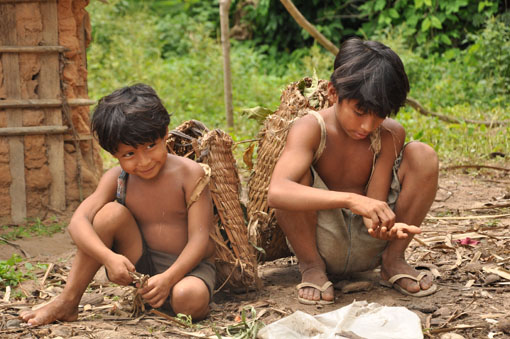 Later, when Willow and I read through the translation, we are both hit by a wave of sadness. We retire early to our hammocks and painful thoughts spin around our heads. Pikawaja is now back in the forest, at a hunting camp, where she feels far happier and at home compared to village life.
Later, when Willow and I read through the translation, we are both hit by a wave of sadness. We retire early to our hammocks and painful thoughts spin around our heads. Pikawaja is now back in the forest, at a hunting camp, where she feels far happier and at home compared to village life.
Pikawaja’s is not an unusual story. Louis Forline, a leading anthropologist on location with us, who was worked with the Awá-Guajá for almost 20 years, tells me that the first Awá community to be contacted lost 75% of its members. It was mainly the elders who died, until they started to build immunity to common diseases. The Awá-Guajá have now been left with a very young demographic. With so few elders around, and a sentiment of looking to the future, their chosen village leader, who sports a fetching orange Mohawk, must barely be out of his teens.
There are now just under 400 Awá-Guajá remaining in the world. It’s estimated that around 60 of them are still uncontacted and live in the forests around where we were filming. They are currently in danger from poachers, miners, loggers and cattle ranchers who have accessed their territories and are ransacking parts of their reserve. And with part of the Carajás Mining venture’s 910km railway running along their doorsteps they really are feeling the squeeze. While FUNAI, the Brazilian government’s National Foundation for Indians, has a policy of not contacting Isolated Indians, there is talk afoot that it may be in the best interests of these last true forest dwellers to integrate them into a village, perhaps even the one we’ve been filming in.
After my interview with Pikawaja I can now start to imagine what it will be like for these uncontacted people who still live nomadically in the forest, if they too are thrown into a world of horse riding, action movies, film crews and the common cold.
The issues go far deeper than I can begin to summarise here. As Indian policy in Brazil is in a constant flux, Louis believes that prospects for the Awá-Guajá future are hanging in the balance. He’s keen to raise awareness of the Awá-Guajá and their current situation; hopefully our programme will prompt further recognition of their lives. FUNAI and healthcare organisations are among those working hard for the welfare of the Awa-Guaja, but they do not always have all the resources they need.
It’s a complicated tangle being played out amongst Amazonian groups - how to balance the changing influential factors in life and identity amidst an ever-changing set of attractions and influences.
State of Play : a Dialogue
by Brian Leith, Executive Producer
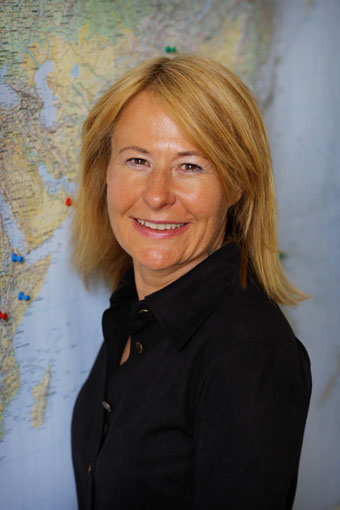 and Dale Templar, Series Producer
and Dale Templar, Series Producer
************************************************************
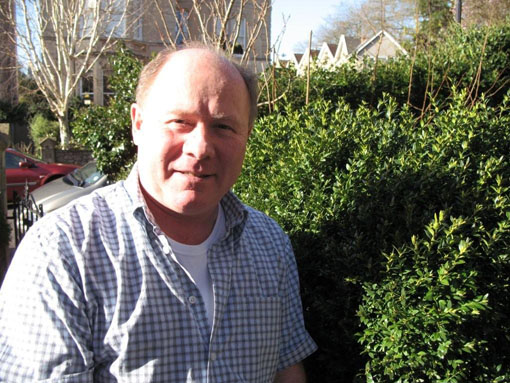 Well, 8 months to go now until we deliver the series. For many programmes, and most producers, this might seem like an eternity… But for us it seems like the day after tomorrow…
Well, 8 months to go now until we deliver the series. For many programmes, and most producers, this might seem like an eternity… But for us it seems like the day after tomorrow…
 Correction….It actually feels like tomorrow!
Correction….It actually feels like tomorrow!
When you start working on what we in TV land call a “landmark series”, a three year production cycle does feel like an eternity. For the first year it feels as if you are pushing a snowball up to the top of a hill. Year two and it starts rolling down, gradually building momentum and growing in size and now in year three the snowball is huge and rolling at speed with us all trying to keep it in control as it hurtles towards the finishing post! (I’ve used this metaphor because there are huge flakes of snow falling here in Cardiff and we’ve been working on the first edits of the Arctic episode). Over to you, Brian..
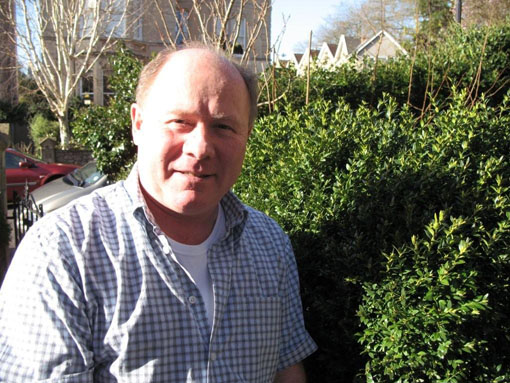 It feels like the Arctic here in Bristol too… it’s started snowing here as well, and the forecast is for heavy (ie traffic-stopping) snow today and tomorrow all over SW England and South Wales (several of us on the HP team were brought up in North America and we find it mildly pathetic, if amusing, how little snow seems to bring this mighty empire to its knees… in Montreal when I was a boy we’d get 6 inches of snow overnight and the snowploughs would be out clearing the roads before the sun rose. True!)
It feels like the Arctic here in Bristol too… it’s started snowing here as well, and the forecast is for heavy (ie traffic-stopping) snow today and tomorrow all over SW England and South Wales (several of us on the HP team were brought up in North America and we find it mildly pathetic, if amusing, how little snow seems to bring this mighty empire to its knees… in Montreal when I was a boy we’d get 6 inches of snow overnight and the snowploughs would be out clearing the roads before the sun rose. True!)
Gosh - apologies for that diversion!
Back to post-production, please, Dale: when do our edits start?
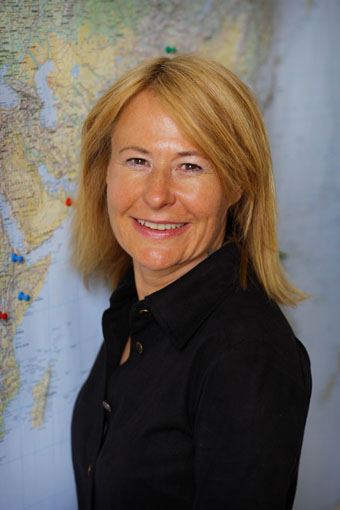 We go into edit in just a few weeks. Each hour of television takes ten or eleven weeks to cut. That includes the 10 minute “Making of”, where you get to see some of what goes on behind the cameras. After that we have several weeks of final post production or finishing which includes dubbing, mixing and voice-over plus the grade where the HD pictures really come to life. Many people get involved during this process, don’t they, Brian …..?.
We go into edit in just a few weeks. Each hour of television takes ten or eleven weeks to cut. That includes the 10 minute “Making of”, where you get to see some of what goes on behind the cameras. After that we have several weeks of final post production or finishing which includes dubbing, mixing and voice-over plus the grade where the HD pictures really come to life. Many people get involved during this process, don’t they, Brian …..?.
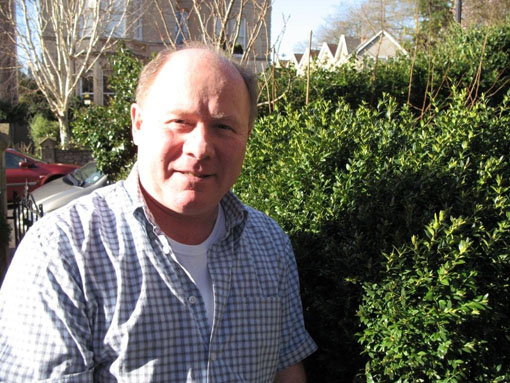 Ahem, cough splutter, yes indeed…
Ahem, cough splutter, yes indeed…
(Gee thanks Dale). Don’t get me wrong: we do need fresh eyes - to keep us pointing in the right direction, to make sure we’re making the programmes as strong as they can be. And it is easy to get so close to a programme that you can’t see the wood for the trees - so regular and constructive editorial feedback and guidance from well-informed senior execs is crucial…
But the reality is that it can get difficult. What if BBC wants a slightly different editorial angle from our other international co-production partners (who may have contributed just as much funding)? Who should we obey? What if someone new steps in to run the channel and they’re not as keen on the series as the previous controller? It has been known for new controllers to ‘kill the babies’ of previous incumbents – like male lions taking over a pride – in order to give their own offspring a better chance.
The truth is that the final approach to landing the finished series can be fraught with delays, disagreements and tension.
Luckily this won’t happen on Human Planet. We have total faith in all our esteemed editorial leaders from all our co-production partners. Don’t we, Dale?
Totally!! Got to go now - I’ve got a literal and metaphorical snowball to push!
Next week we have to present the series - a 20-minute Brian-and-Dale show - to the new Chief Creative Director of BBC Vision, then to BBC Worldwide’s Showcase - a three day jamboree of all the BBC’s potential international co-production partners - to try and rustle up as much interest as we can in the series.
These landmark series can be huge international best-sellers - Planet Earth is still selling like hotcakes as DVDs around the world - so the pressure’s on! It’s a weird time on one of these big series: on the surface we’re trying to exude calm certainty that it’s all going to be wonderful - the best series since sliced bread! and meanwhile we’re frantically pedalling like mad below the water-line to make sure it all comes together on time and on budget…
Ground Control (to PD Tom!)
by Joanna Manley, Production Coordinator, Jungles/Oceans team
Being the Production Coordinator on the Jungles and Oceans team means I’m responsible for sending Tom, Charlotte, Willow and Rachael to Jungles and Oceans all over the world. I seem to be in a constant state of organised chaos and even though I get left behind with the damp life jackets and lingering smell of the Jungle whilst the team flies off to the next amazing destination, I love my job and my team.
I have several time zones set on my phone which I continuously update as teams leave, come back, move on and go out again. It’s sometimes difficult to keep track of where everyone is and invariably they all phone at the same time (usually just as I’m trying to get some lunch!) needing a new camera, flights changed or just someone back in reality to talk to when they’re in the middle of a wet jungle with broken kit and infected feet!
On Human Planet we’re often dependent on people and animals being the same place at the same time when the conditions are right. This is how not to do it….
We had;
Jon in Indonesia trying to film a Whale Hunt close to two earthquakes
Charlotte trying to film a shark whilst there was a tsunami warning for the area
Willow in Bristol trying to track Hurricanes to film in the Caribbean and there weren’t any
Tom and Rachael leaving for the Philippines to live on a boat for 7 days in the midst of the worst typhoon season the Philippines have seen in years.
How typical!
With so many shoots going off and coming back and with heaps of kit needed, our office has got a reputation for a being a bit of a muddle. Danny who delivers post to our office says he has nightmares about it and grumbles it’s like an assault course trying to get from one side of the room to the other. To be honest he’s right, especially as there is a camouflage theme to a lot of the objects such as hammocks, tarps, tents and thermarests. We’ve got wetsuits and life jackets hanging off the back of the door, waterproof bags and jungle ponchos in a heap behind my desk with a solar shower perched on top and on Tom’s desk at the moment is a pile of coconut shells used to call sharks in Papua New Guinea.
My two sets of desk drawers are filled with all sorts of things not usually found in an office drawer…
Muddy batteries from the jungle
Leaking bottles of anti mosquito repellent
Boxes of antibacterial hand wash
A box of latex gloves for covering radio mics
Several dead Central African Republic bees
A tangle of 4 way plug adaptors and extension leads
I’ve got a heap of tapes, gaffer tape and loose cable ties all over my desk and a pair of size 12 flippers along with three Mauritanian jilbabs the team wore whilst filming in Mauritania to the side of my drawers.
Even though I don’t get to see the places we’re filming in person I get a good idea of what’s it like there even before I see the footage. From the smells emerging from their kit bags when they get back, to the sound of pouring rain and bugs I hear in the background when I’m talking to them on the Satellite phone.
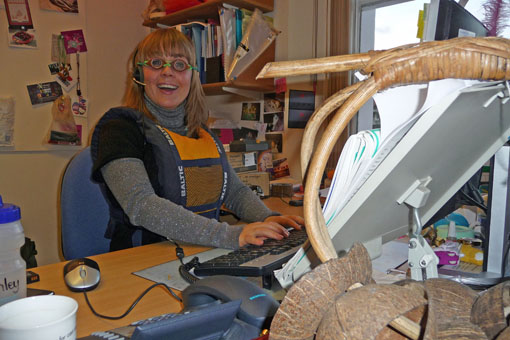
You need a sense of humour in this job! Here I'm wearing wooden goggles from Bajau divers and a lifejacket, next to some shark-calling coconuts
Our next shoot is going off to Brazil on 8th January so we’re battling through our Christmas party hangovers to get everything packed up and ready so we can take a much needed break before another crazy year on Human Planet starts!
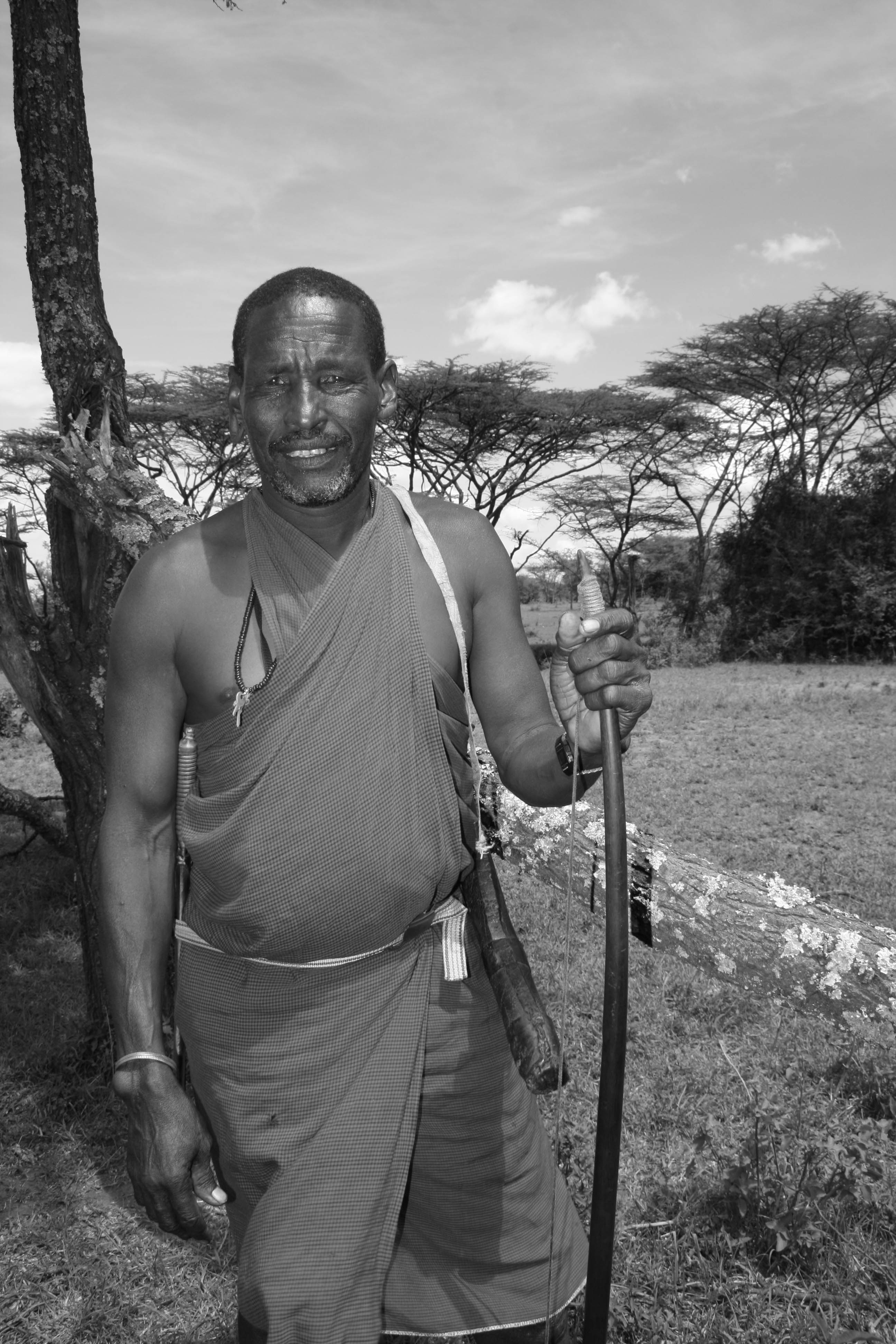

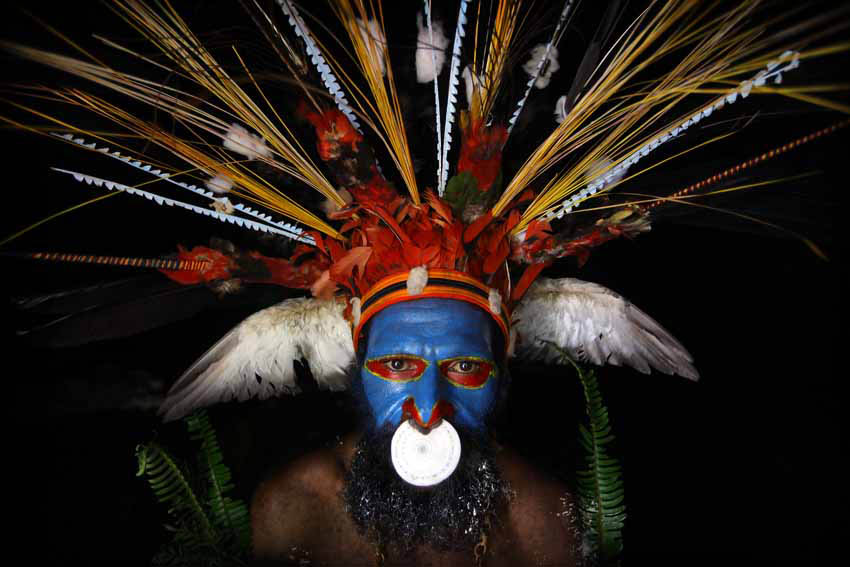




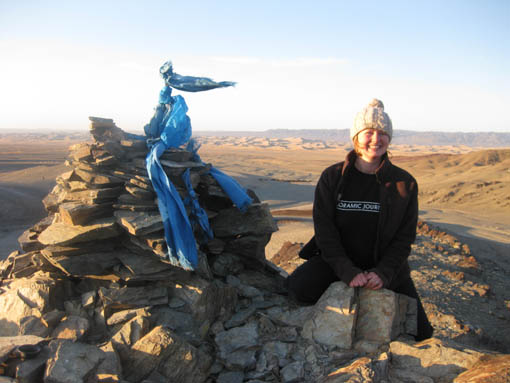
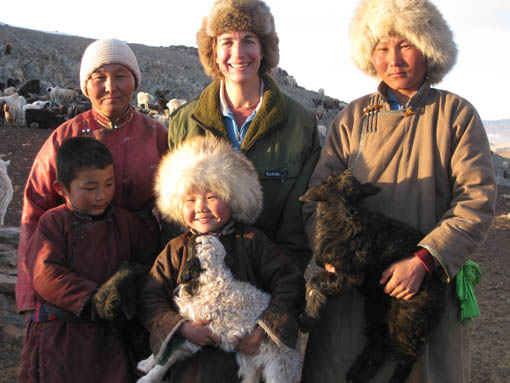
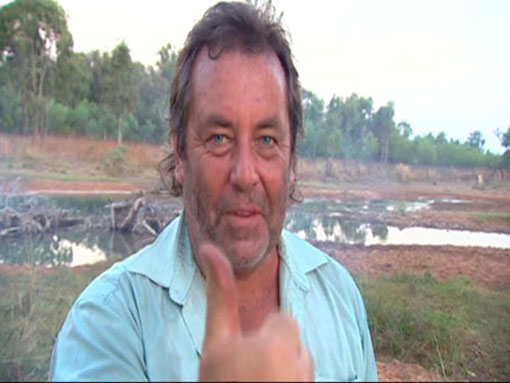
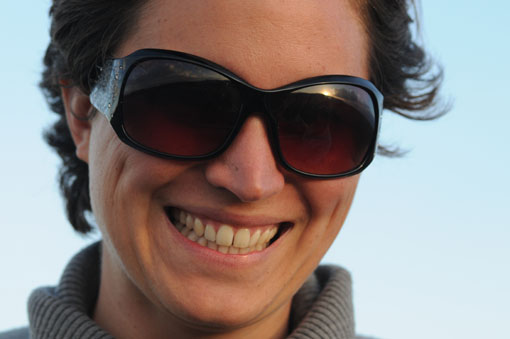
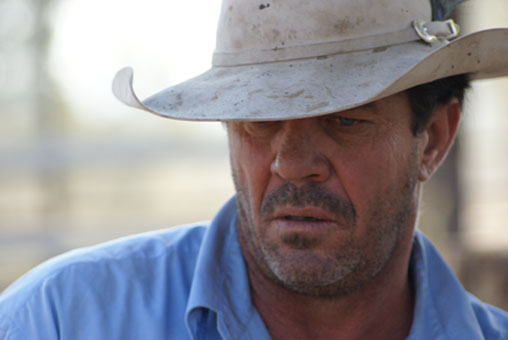
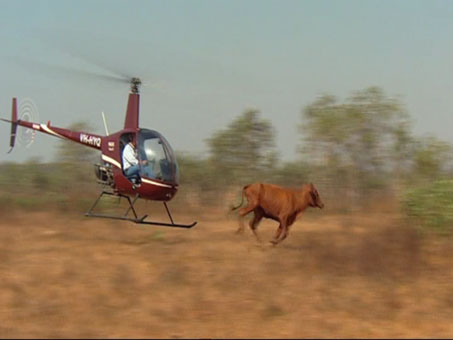
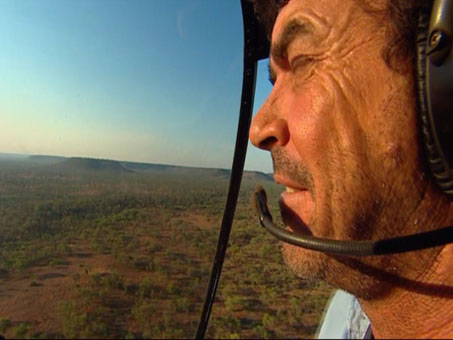
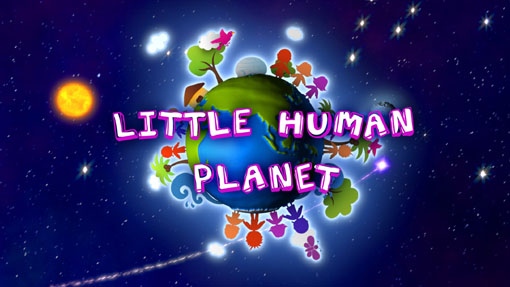
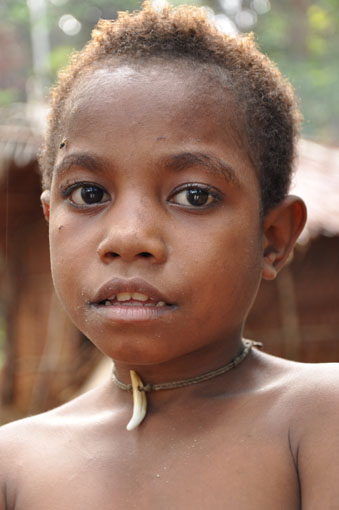
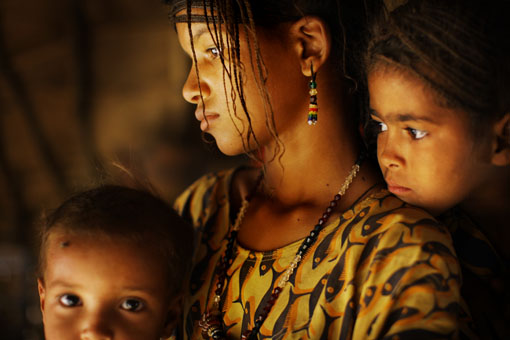
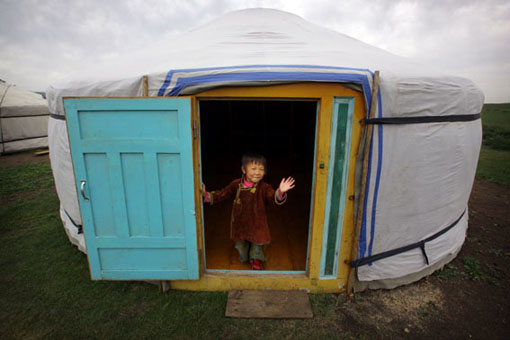
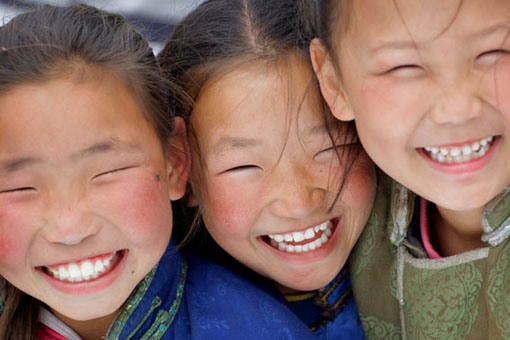
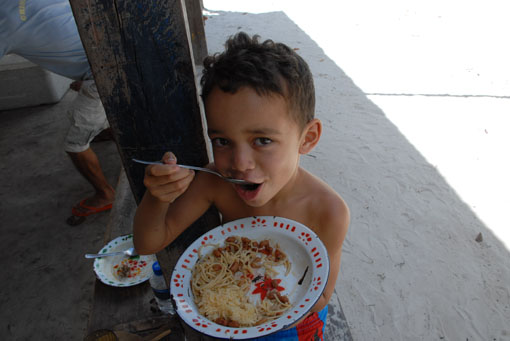
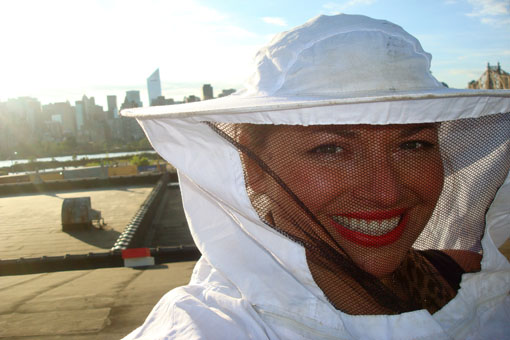
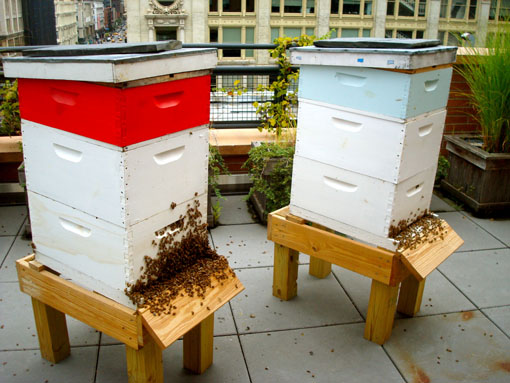
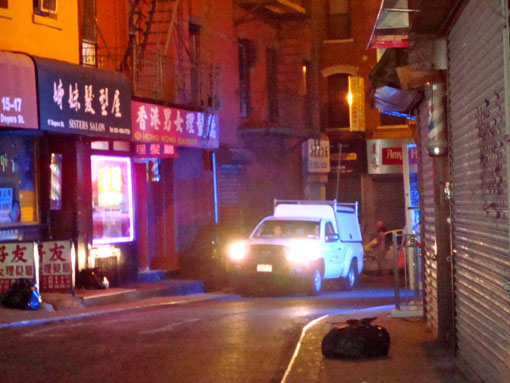
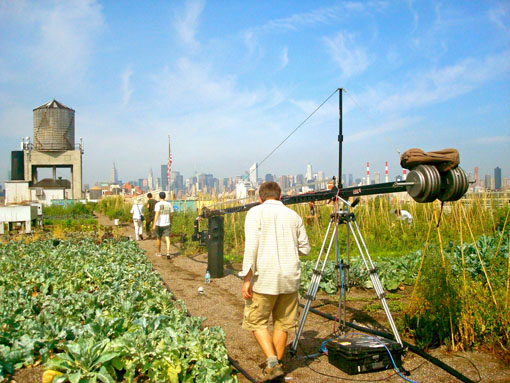
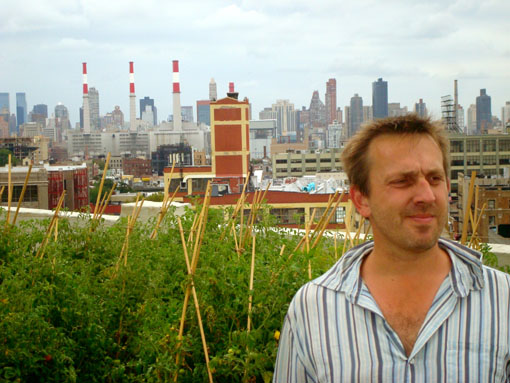
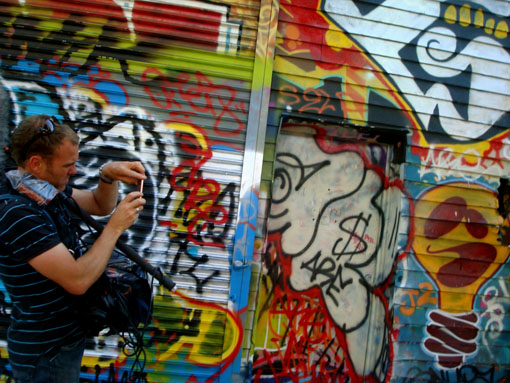
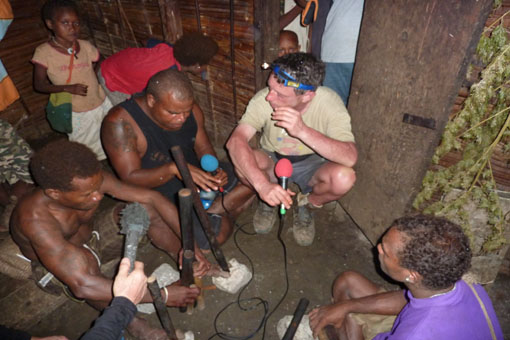
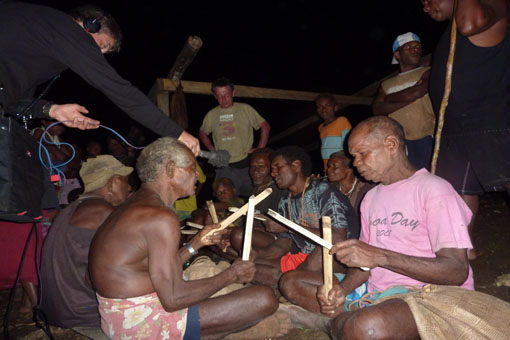
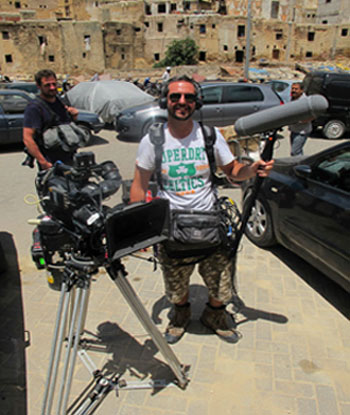
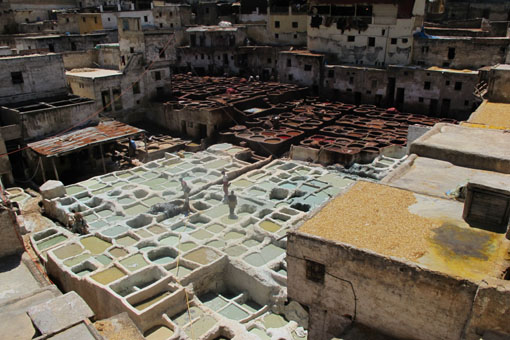
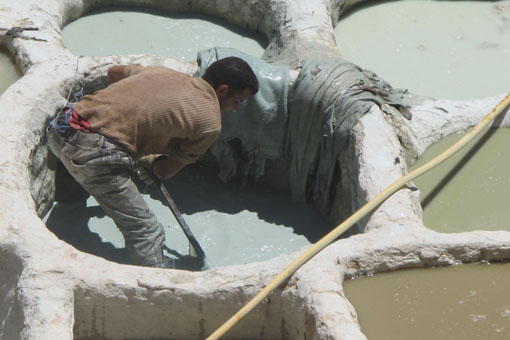
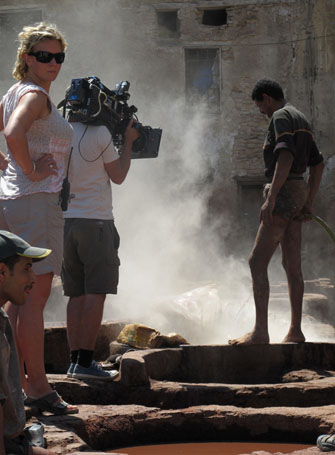
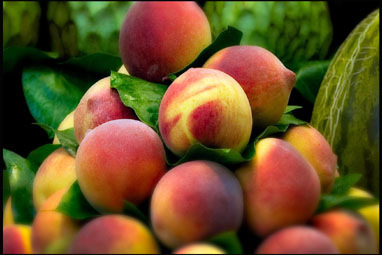
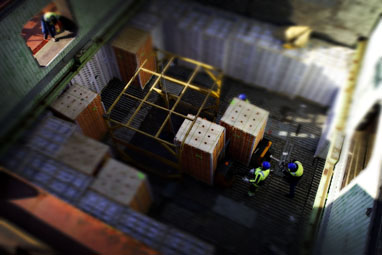
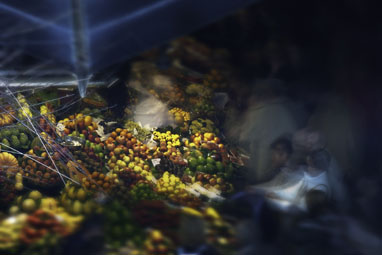
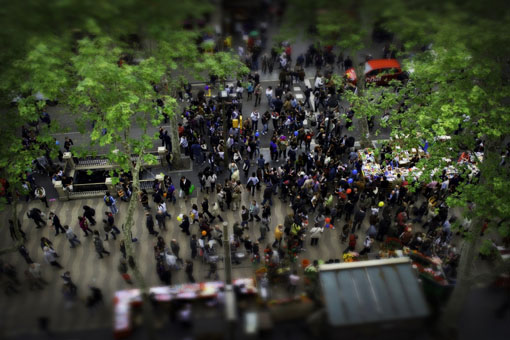
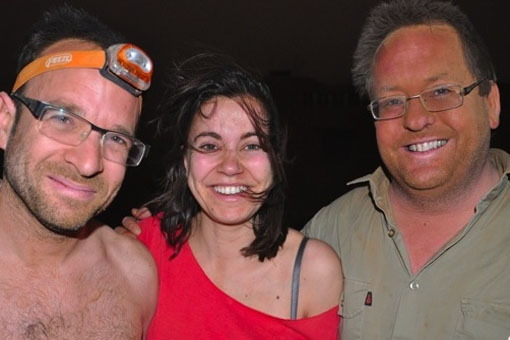
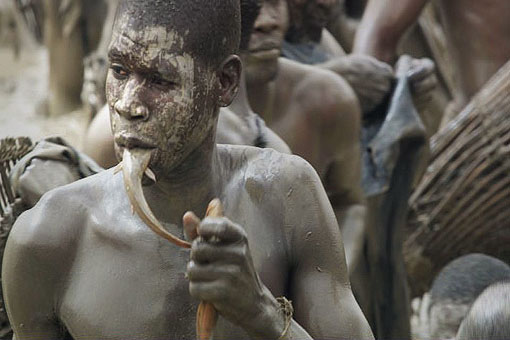
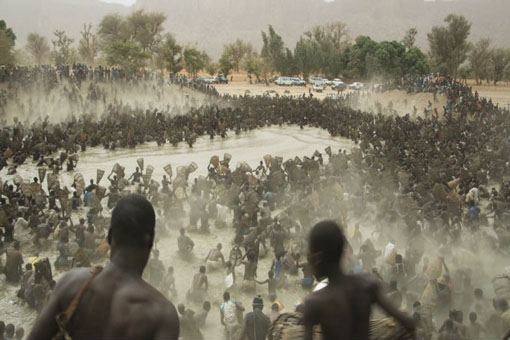
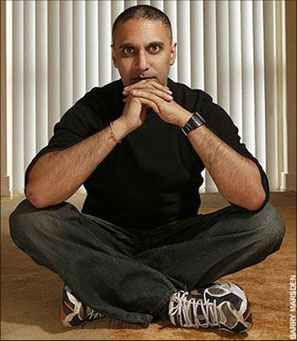
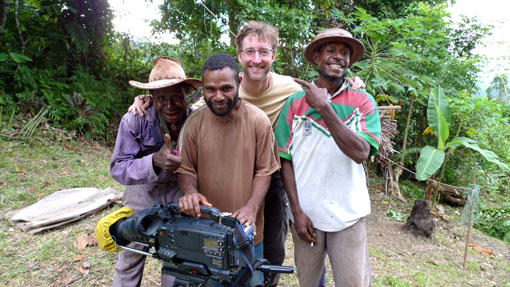
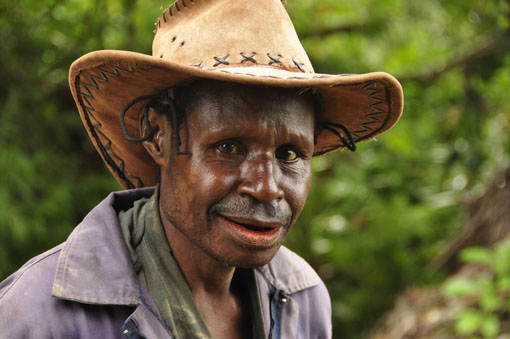
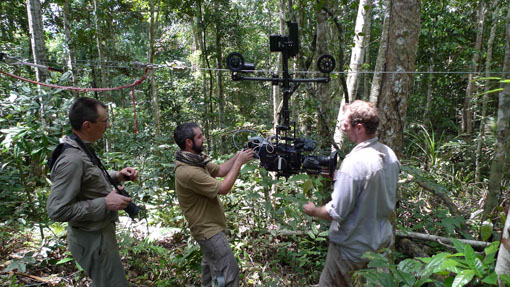
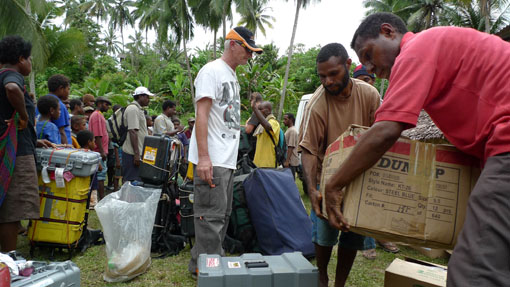
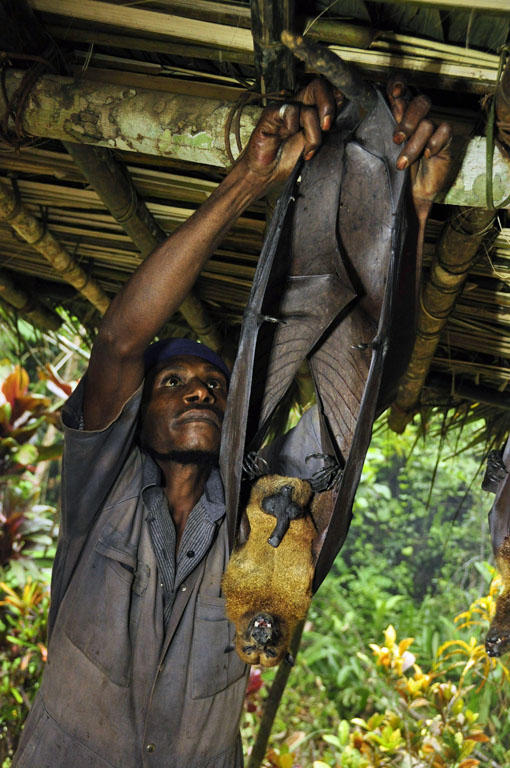
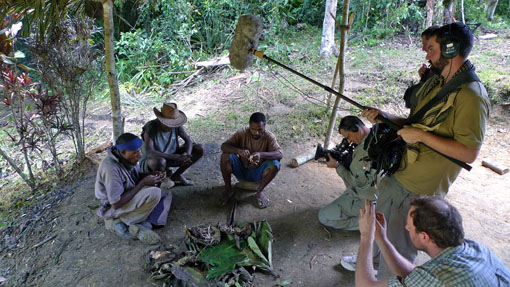
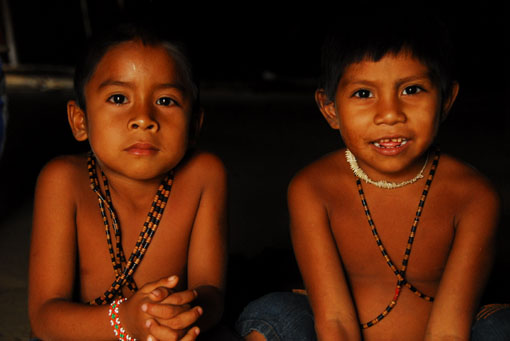
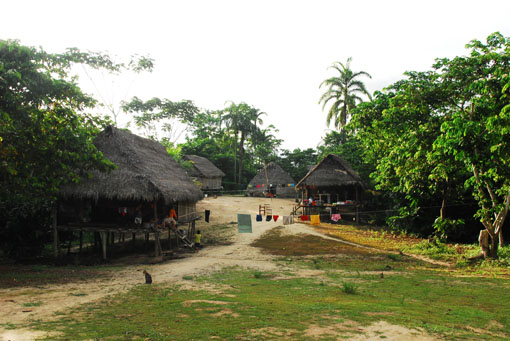
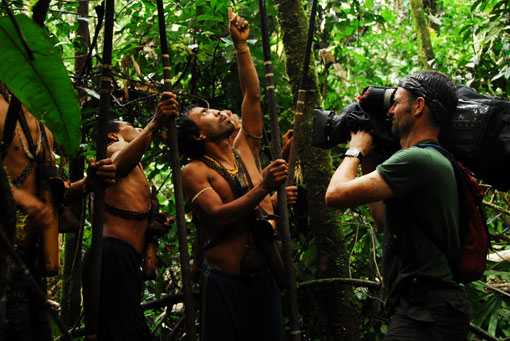
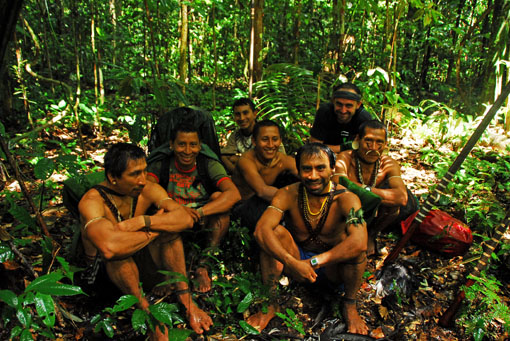
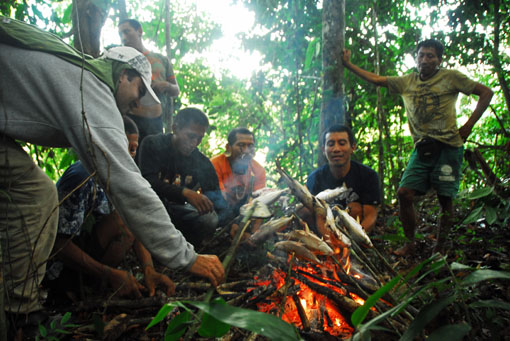
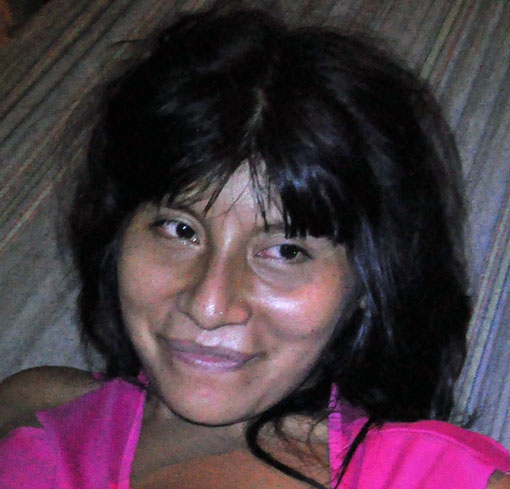
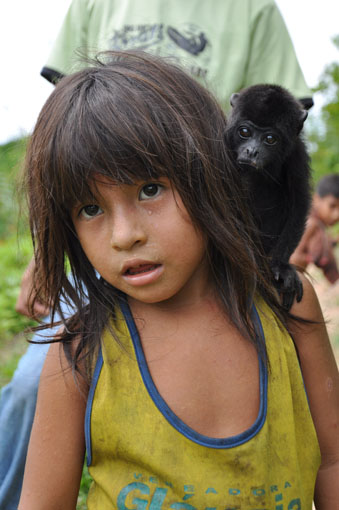
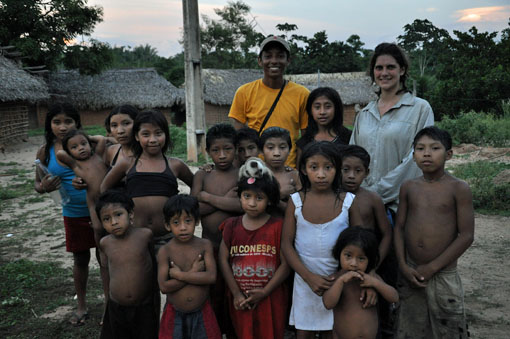
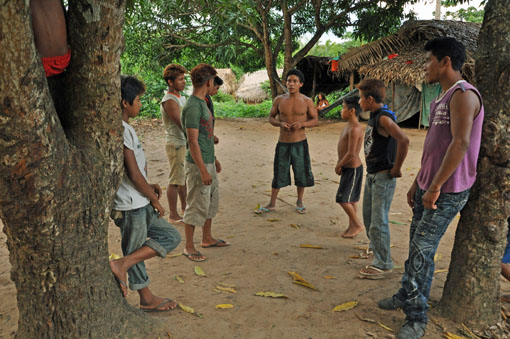
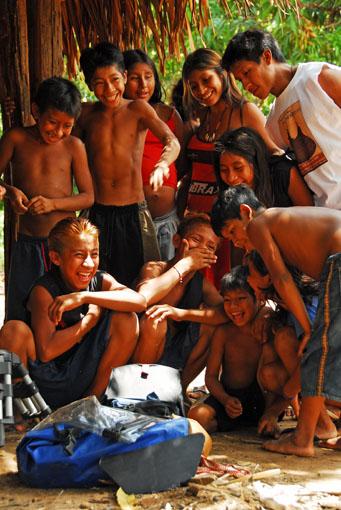
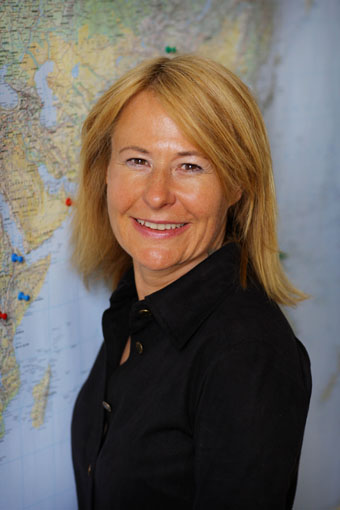
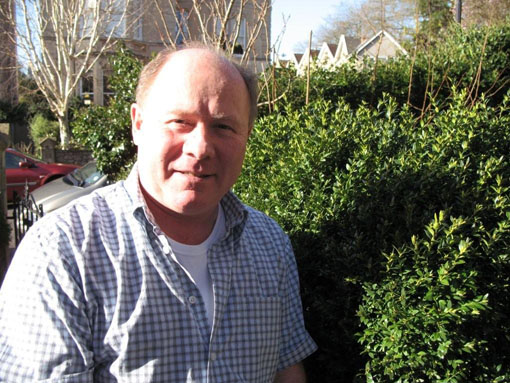
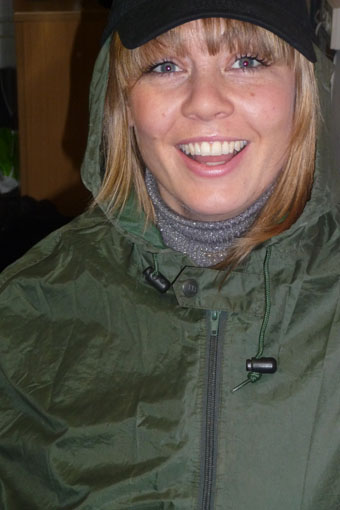
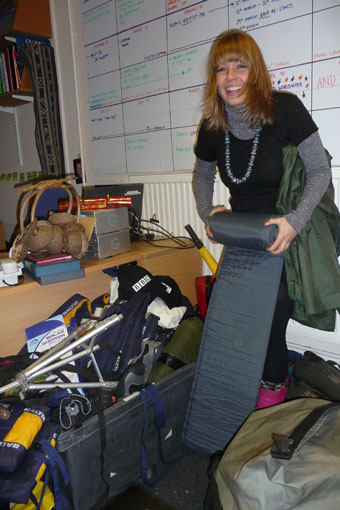
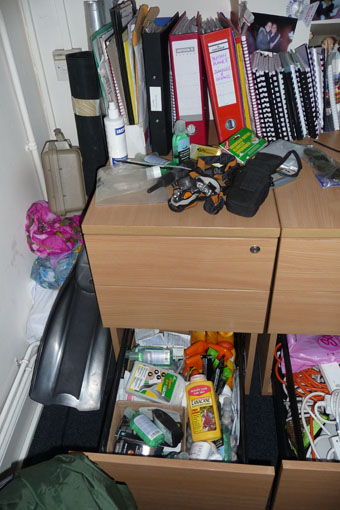

Mr. Hurt, I Presume?
by Dale Templar, Series Producer
John Hurt
When you’ve worked in television for over 20 years you get quite used to meeting and working with famous people. There are very few encounters that have ever really fazed me. One exception was meeting George Michael in a studio at the height of his solo career in the early 90s and, more recently, literally bumping into David Beckham behind the scenes at the O2 in London, with a beefburger in my mouth.
Well, a few weeks ago I was in another recording studio in Hampstead, North London waiting to meet one of our most truly talented British actors. I spotted him as he came through the door of the studio canteen and, as I walked towards him, a vast array of movies and characters flashed before me. Here was “The Elephant Man”, ” The Naked Civil Servant”, Harry Potter’s eccentric wandmaker and finally that stomach bursting scene from “Alien” leapt into my mind! Yes, it can now be officially confirmed that John Hurt is the voice of “Human Planet”. And what a voice! As soon as he shook my hand and said a simple “Hello, nice to meet you”, I just couldn’t wait to start our voice record session.
We spend months in edit cutting the pictures, crafting the films visually but we listen to the programmes with what we call scratch voices on them. At this stage, the script is usually recorded by the episode producer or, sometimes, the picture editor. They always do a great job but when the script is finally locked and we finally get to put on “the voice of the series”, a instant transformation occurs. The narrator gives it a unique identity. John’s resonant, commanding yet warm voice wraps itself around the pictures and draws you into the action and the characters. As I expected John was a consummate professional and we all worked incredibly hard, recording the voice-over for both the Arctic and Oceans episode. This is not an exact science but every line, every word is scrutinized. John had six sets of professional ears, including his own (which was usually the most critical), making sure everything was perfect.
What I loved was John’s dry sense of humour. In the Arctic script we do a scene which is effectively written as a pastiche of a television cookery show, of which we have many in the UK. Here was John Hurt doing his own wonderful interpretation of Delia Smith, or one of that ilk, reading out a recipe for how to prepare Kiviak, a Greenland delicacy, made from unplucked Arctic birds and a sealskin. A classic moment I will never forget.
Aug 20, 2010 | Categories: On Location | Tags: arctic, BBC; Human Planet;, commentary, Dale Templar, Greenland, John Hurt, Kiviak, narrator, oceans | Comments Off